Whether you’re craving the serenity of a lush forest, a refreshing seaside breeze, or a good glass of wine, this list of the best day trips from Tokyo has everything you need to escape the city for a while.
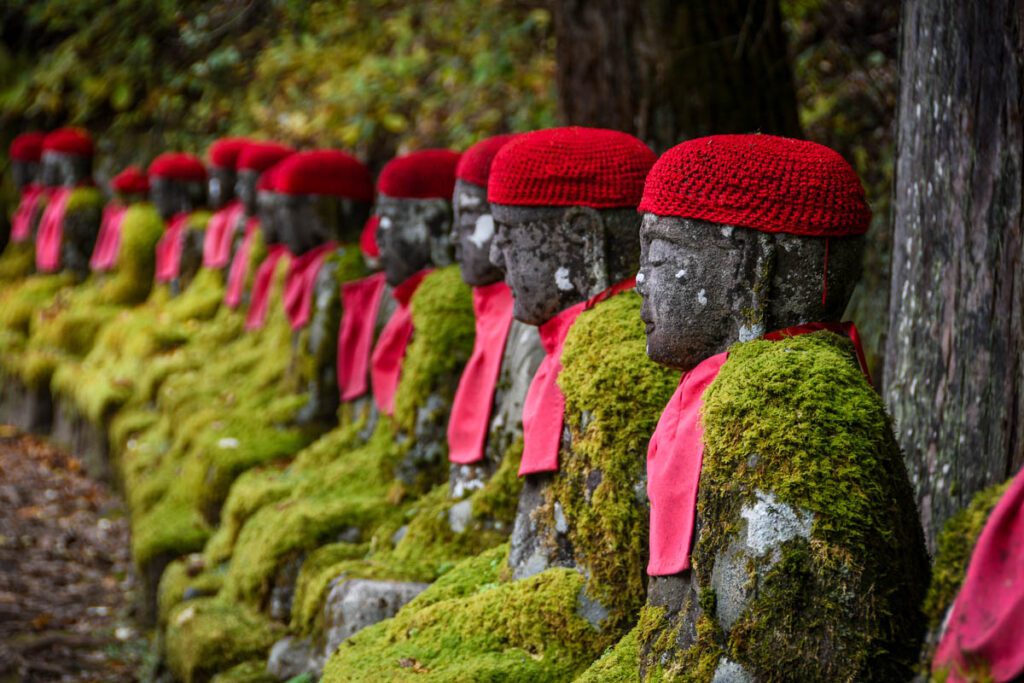
For a big city adventure, you just can’t beat Tokyo. The sprawling capital of Japan has everything, from street food to fine dining, gleaming skyscrapers to historic shrines, the stillness of a zen garden to the hustle and bustle of the world’s busiest train station.
No, but it literally has everything – even its own Disneyland and Statue of Liberty.
There are endless exciting things to do in Tokyo. But sometimes you need a break, ya know?
Within just a few hours of the city, you can experience so much more of what Japan has to offer.
Day trips from Tokyo
- Kamakura
- Nikko
- Fuji
- Yokohama
- Hakone
- Arakurayama Sengen Park
- Hitachi Seaside Park
- Lake Kawaguchi
- Akiruno
- Wine country: Yamanashi Prefecture
- Chichibu
- Mt. Nokogiri
- Kawagoe
- Karuizawa
- Sayama Hills
Keep reading for more detailed information on each of these destinations and more ideas for fun day trips from Tokyo. And if you’re wondering how to get to all these awesome places, jump down to the transportation section.
Note: The distances and travel times for each of these day trips are estimates and may vary depending on where you’re staying in Tokyo.
Now let’s get to it, shall we?
1. Kamakura
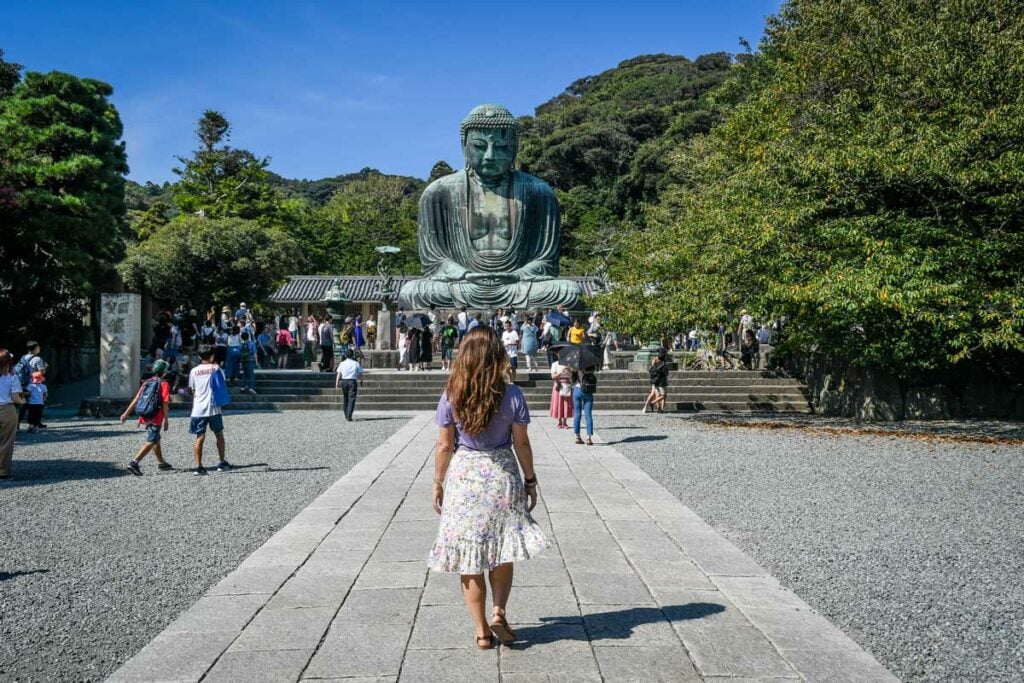
- At a glance: charming city with iconic Great Buddha statue
- Distance from Tokyo: 59.6 km / 37 miles
- Time: 1 hour train ride / 58 minutes driving
Like Kyoto and Nara, Kamakura was once a political capital of Japan. It’s known as the birthplace of both yabusame (horseback archery) and the first samurai government. Now, it’s an eclectic mix of historical and cultural heritage, temples and shrines, and hip, artsy vibes not unlike Southern California.
There are no less than 65 temples and 15 shrines in Kamakura, each with something different to offer.
Kotoku-in Temple is home to the symbol of Kamakura, a colossal bronze statue known as the Great Buddha. Nearby, Hasedera Temple houses Japan’s tallest wooden statue in the gilded likeness of Kannon, the Goddess of Mercy. Tucked away in the hills, Hokokuji Temple is a hidden gem with a quaint teahouse in an airy bamboo forest.
In addition to its high concentration of temples and shrines, Kamakura is also known as a popular seaside getaway. With 7 km (4.4 miles) of coastline and 5 beaches, it’s the perfect location for anyone visiting Tokyo in the summer looking for some sand and surf.
Top things to do in Kamakura
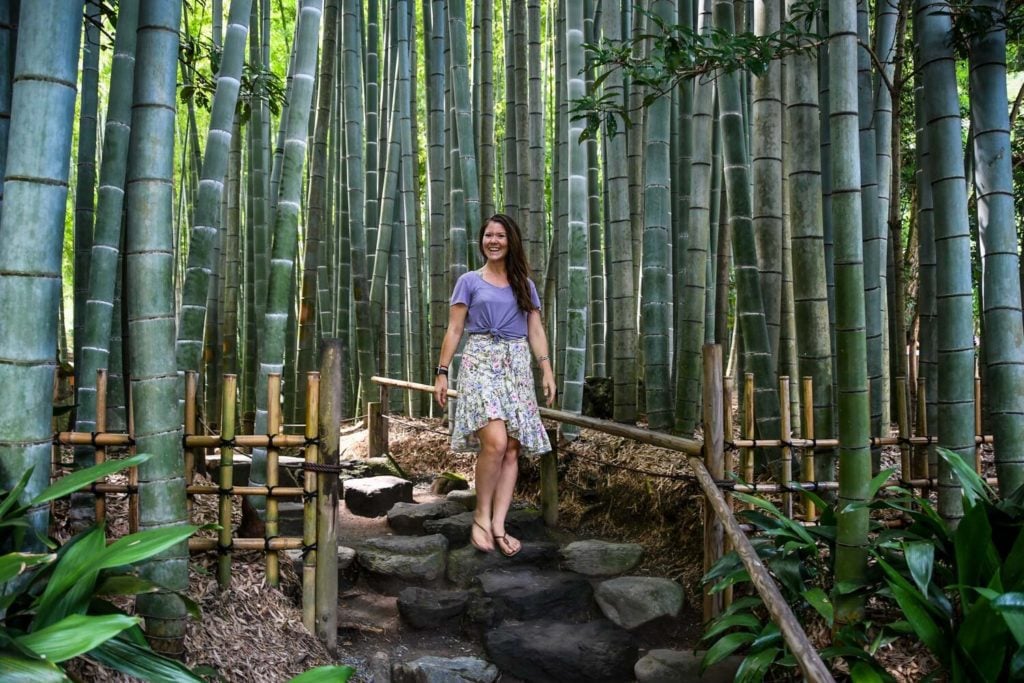
- Marvel at the Great Buddha. Also known as Daibutsu, this statue at Kotoku-in Temple is one of Japan’s most iconic landmarks and a must-see in Kamakura.
- Hike to temples and shrines. Combine nature, culture, and history on one of these hiking routes:
- Daibutsu trail: Beginning at Kita-Kamakura Station, this 3.7 km trail (2.3 miles) makes its way to the Great Buddha, passing Tokeiji Temple and Jochiji Temple along the way. Afterward, you can follow this route to continue on to Hasedera Temple.
- Ten-en trail: Known for its stunning fall foliage, this 7.9 km trail (4.9 miles) runs from Kenchoji Temple through the scenic Shishimai Valley to Zuisenji Temple.
- Gionyama trail: The perfect choice for an easier hike, this 1.1 km (0.68 mile) trail will take you to both Yakumo Shrine and Harakiri Yagura, the burial cave of the famed samurai Hojo Takatoki.
- Sip tea in a bamboo forest at Hokoku-ji Temple.
- Catch a wave at Yuigahama Beach. It’s a little known fact that surfing is a beloved sport in Japan, and Kamakura is the best place near Tokyo to experience it. On a clear day, you can even hang ten with a view of Mount Fuji!
- Shop for Japanese souvenirs on Komachi-dori, a lively street lined with shops and eateries offering local specialties.
- Go to Zushi Beach for sunset and get a drink and snacks at Surfers.
How to get there
By train: From Shinagawa Station, take the Yokosuka Line to Kamakura Station.
By car: Take Route 1 southbound out of Tokyo, following signs for Metropolitan Expressway Kanagawa Route No.1/Yokohama. Stay on Route 1 as it turns into K1. At the Kinko JCT interchange, follow signs for Kanagawa Route No.2 and continue on K2. Take the Yokohama-Shindo Road exit toward Totsuka/Fujisawa. Continue on E83 until Kagetorichō intersection. Turn left onto 402, then right on 312, and left on 32.
By guided tour: This highly-rated tour combines the highlights of Kamakura with a visit to Enoshima Island for a full day of sightseeing.
2. Nikko
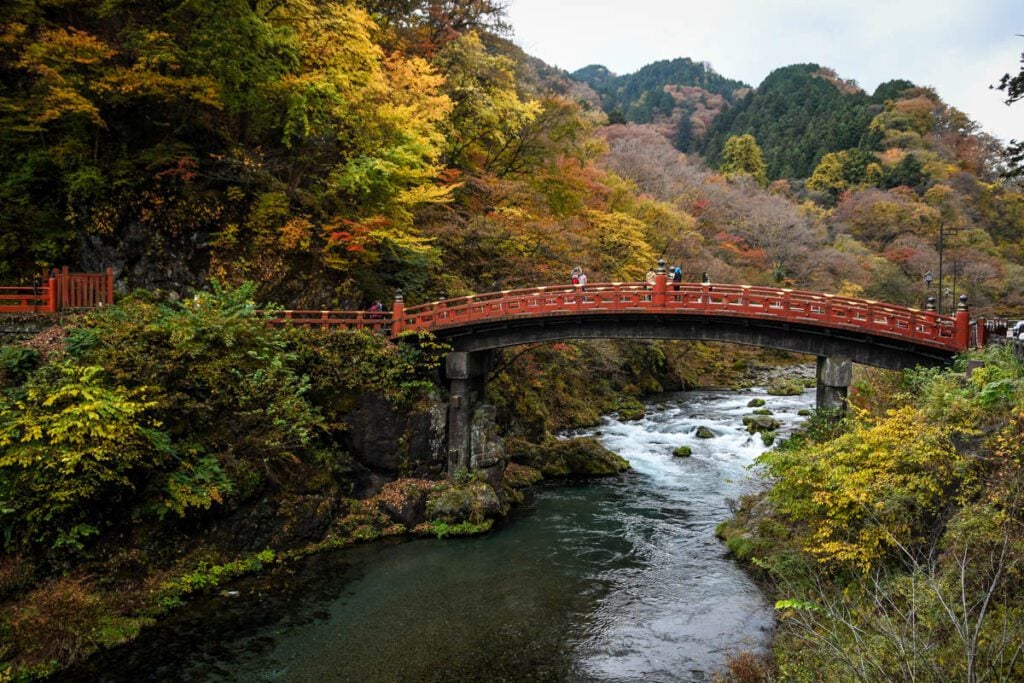
- At a glance: ancient city renowned for its natural beauty and World Heritage status
- Distance from Tokyo: 151 km / 93.8 miles
- Time: 2 hour 11 minute train ride / 1 hour 50 minutes driving
Resting in the mountains north of Tokyo is the beloved local treasure of Nikko, one of the most beautiful places to visit in Japan.
In fact, this region is so mesmerizing that the Japanese even gave it its own saying: “Don’t say magnificent before having seen Nikko.”
Religious complexes line the city, creating an ancient wonderland of Shinto shrines, Buddhist temples, World Heritage Sites, and mausoleums.
Nearby, Nikko National Park offers another tranquil escape in a sea of tall cedars, mountainous landscapes, waterfalls, and hot springs.
Top things to do in Nikko
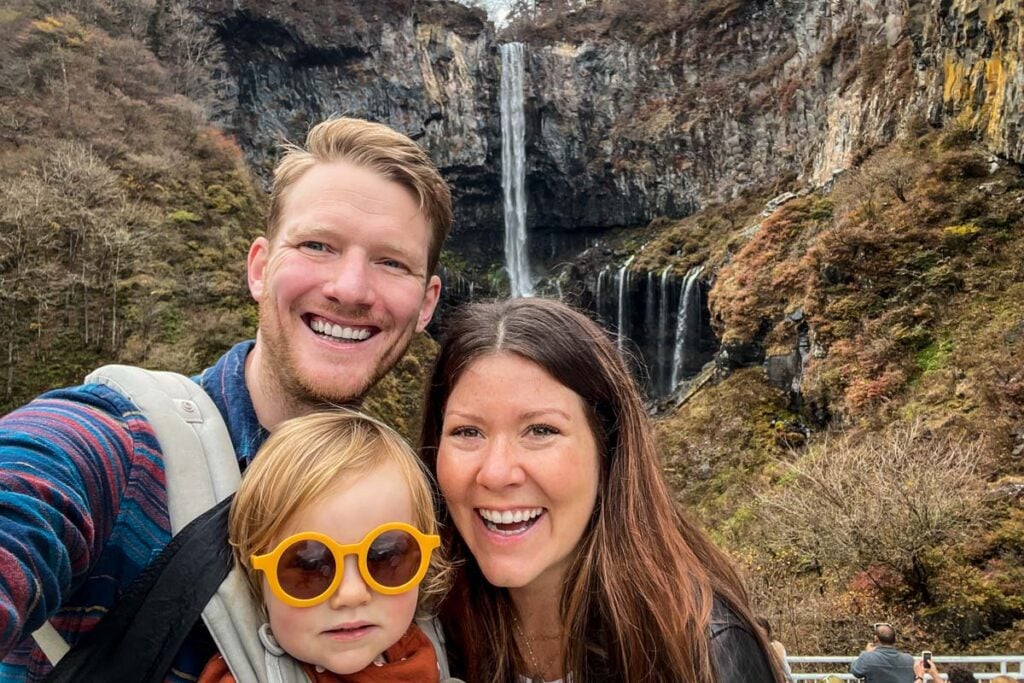
- Witness the awe-inspiring Kegon Falls, one of Japan’s highest cascades set dramatically amidst lush greenery.
- Discover Ryuzu Falls and Yudaki Falls, two waterfalls that are smaller and lesser-known than Kegon, but still worth a visit if you have the time.
- Wander the Kanmangafuchi Abyss. This riverside trail through a volcanic gorge lined with 70 stone Jizo statues was our favorite thing we did in Nikko.
- Explore the diverse landscapes of Nikko National Park, such as waterfalls, hot springs, and hiking trails.
- Enjoy a relaxing boat ride on Lake Chuzenji.
- Cross the red-painted Shinkyo Bridge, the oldest bridge in Japan as well as Nikko’s most iconic sight.
- See the UNESCO-listed Tosho-Gu Shrine. This lavish mausoleum is the final resting place of former shogun Tokugawa Ieyasu.
- Visit Rinnoji Temple, Nikko’s most important temple boasting three 7.5-meter gilded Buddha statues.
- Try yuba, a local specialty of tofu skins (way more delicious than it sounds!).
How to get there
By train: From Kitasenju Station, take the Tobu-Nikko Line to Shimo-Imaichi Station.
By car: Take S1 northbound out of Tokyo, continuing onto Tohoku Expressway (E4). Stay on E4 for about 103 km (64 miles), then take the exit for Utsunomiya IC toward Nikko onto Route 119. Finally, take the exit for Dosawa IC onto Route 121.
By guided tour: This day trip from Tokyo includes stops at Tosho-Gu Shrine and Kegon Falls, as well as some free time to explore Nikko on your own.
3. Fuji Five Lakes area
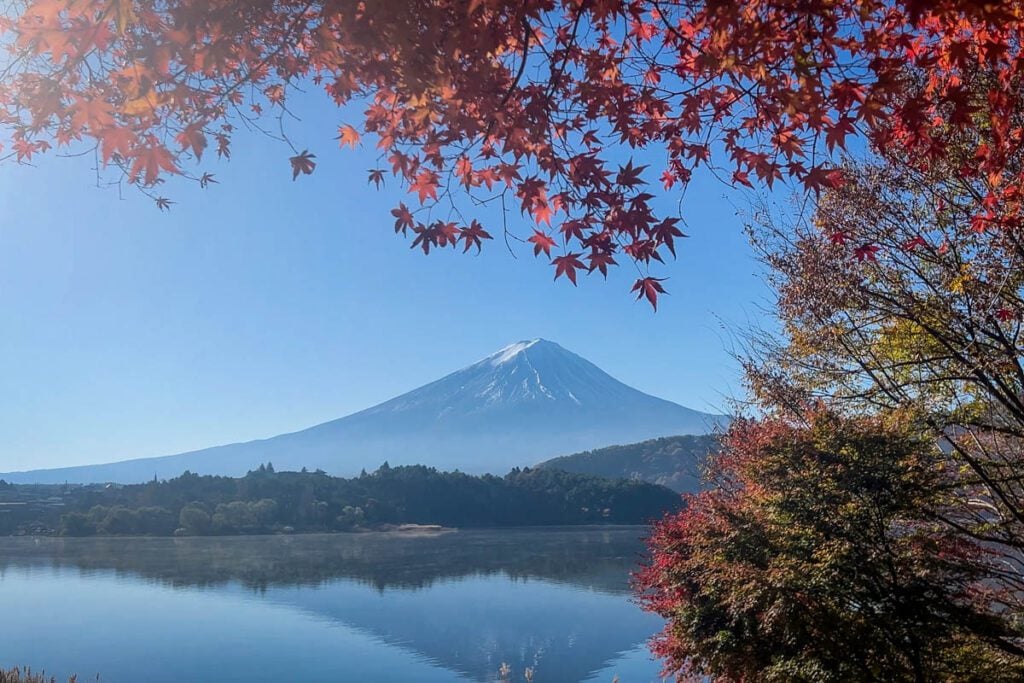
- At a glance: snow-capped volcano and Japan’s most iconic landmark
- Distance from Tokyo: 139 km / 86.4 miles
- Time: 1.5 hour train ride / 1 hour 48 minutes driving
When you think about Japan, the majestic peak of Mount Fuji is probably one of the first images that comes to mind, possibly framed with pastel cherry blossoms or fiery fall foliage. You know, the quintessential postcard shot.
In addition to being wildly popular for photography, Mount Fuji is worshiped by both Shinto and Buddhist religions as one of three sacred mountains in Japan, along with Mount Haku and Mount Tateyama.
Catching a glimpse of the beloved peak is undoubtedly one of the top things to do in Japan, but it comes with a catch: Mount Fuji is notoriously shy.
Despite being Japan’s tallest mountain that can even be seen from Tokyo on a clear day, Fooj is, more often than not, shrouded in cloud or fog, invisible even from nearby viewpoints.
We have firsthand experience with making the trip to see Mount Fuji, only to be met with a wall of gray clouds. To say we were disappointed is an understatement.
But the good news is that, even if you don’t get the postcard view, there’s enough to enjoy in the town of Fuji that it’ll still be worth your time. Besides, you never know, you might just get lucky! (Like we did on —ahem— our third trip to Japan.)
We have a complete guide for the perfect Mount Fuji day trip from Tokyo with all the info you need!
Top things to do near Fuji
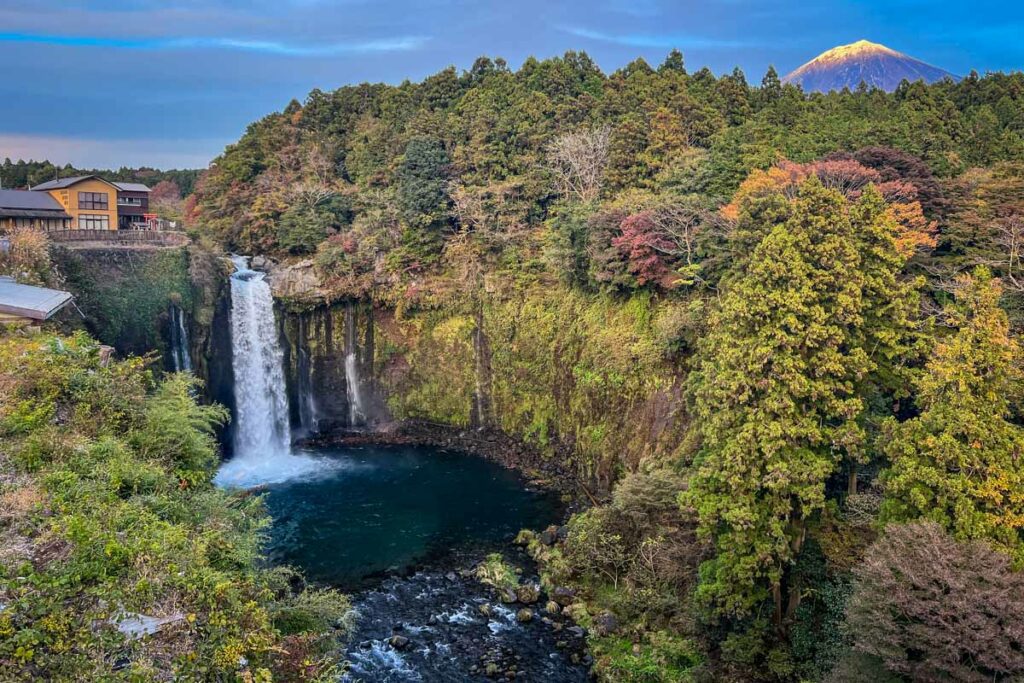
- Climb Mount Fuji. Clocking in at over 3,760 meters (12,335 feet), trekking to the summit is no small feat. Though challenging, Fuji remains one of the most climbed mountains in the world.
- Good to know: The climbing season for Mount Fuji runs from July to early September.
- Peep the peak from these famous viewpoints:
- Lake Kawaguchiko: quintessential lakeside view of Mount Fuji with cherry blossoms or maple leaves in the foreground.
- Arakurayama Sengen Park: iconic view of Chureito Pagoda set against the backdrop of Mount Fuji.
- Explore the Fuji Five Lakes. Made up of Lake Kawaguchi, Lake Yamanaka, Lake Sai, Lake Shoji, and Lake Motosu, this region offers both hiking trails and water activities, each with a unique perspective of Mount Fuji.
- Visit the breathtaking Shiraito Falls. In the foothills of Mount Fuji, thin streams of water cascade over a lush green cliff face nearly 500 feet wide, resembling delicate strands of silk. Shiraito Falls wasn’t on our itinerary originally, but we were so glad we decided to squeeze it in!
- Slurp hoto, a famous hotpot dish local to Yamanashi Prefecture made with thick, hearty noodles and pumpkin in a miso-based broth.
- Discover Kubota Itchiku Art Museum, a display of intricately dyed kimonos with a stunning Japanese garden and teahouse.
- Take a wild ride at Fuji-Q Highland, one of Japan’s most popular amusement parks with Guinness World Record roller coasters.
How to get there
By train: From Shinagawa Station, take the Tokaido-Sanyo Shinkansen to Shin-Fuji Station.
By car: Follow Route 3 out of Tokyo onto E1. Continue traveling southwest on E1 for about 121 km (75 miles), then take the exit for Route 139 at Fuji IC toward Fuji/Fujinomiya.
By guided tour: This affordable tour from Get Your Guide will take you to the most popular Mount Fuji viewpoints, such as Arakura Sengen Shrine and Kawaguchiko Lake (#6 and #8 on this list of Tokyo day trips).
4. Yokohama
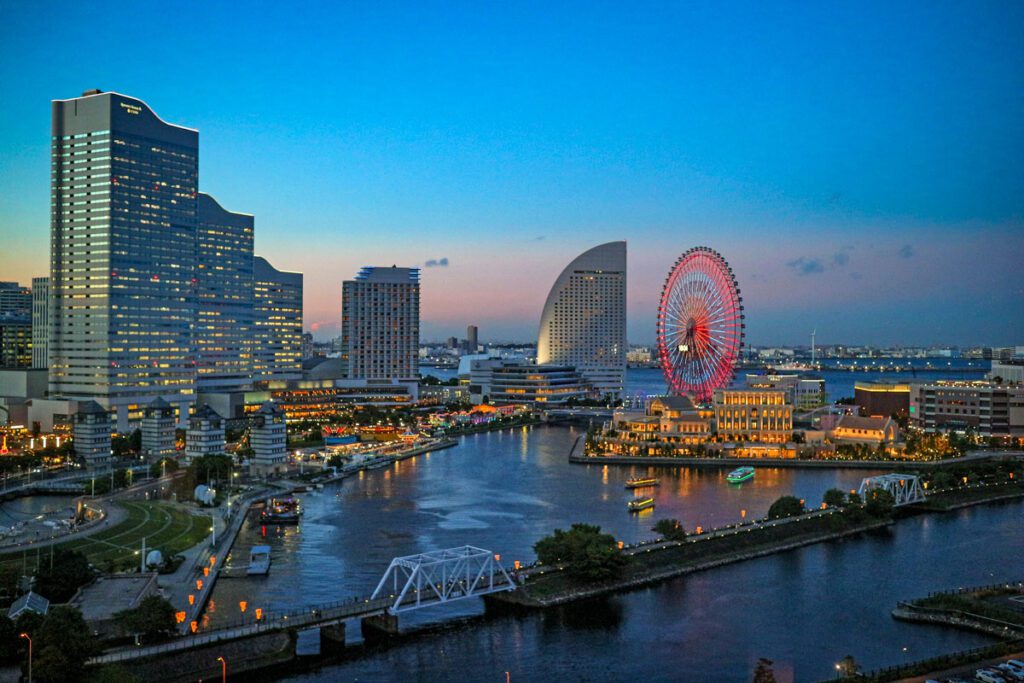
- At a glance: vibrant port city just outside Tokyo
- Distance from Tokyo: 35.8 km / 22.3 miles
- Time: 26 minute train ride / 33 minutes driving
Located about half an hour south of Tokyo, Yokohama is Japan’s second-largest city, as well as a super easy one to zip out to for an exciting day trip.
Yokohama was one of the first ports to open to international trade after Japan’s isolationist Edo Period, so the city is well known for its multiculturalism. In fact, its historic Chinatown is the largest in Japan, with around 500 shops and restaurants offering authentic cuisine, goods, and groceries.
Top things to do in Yokohama
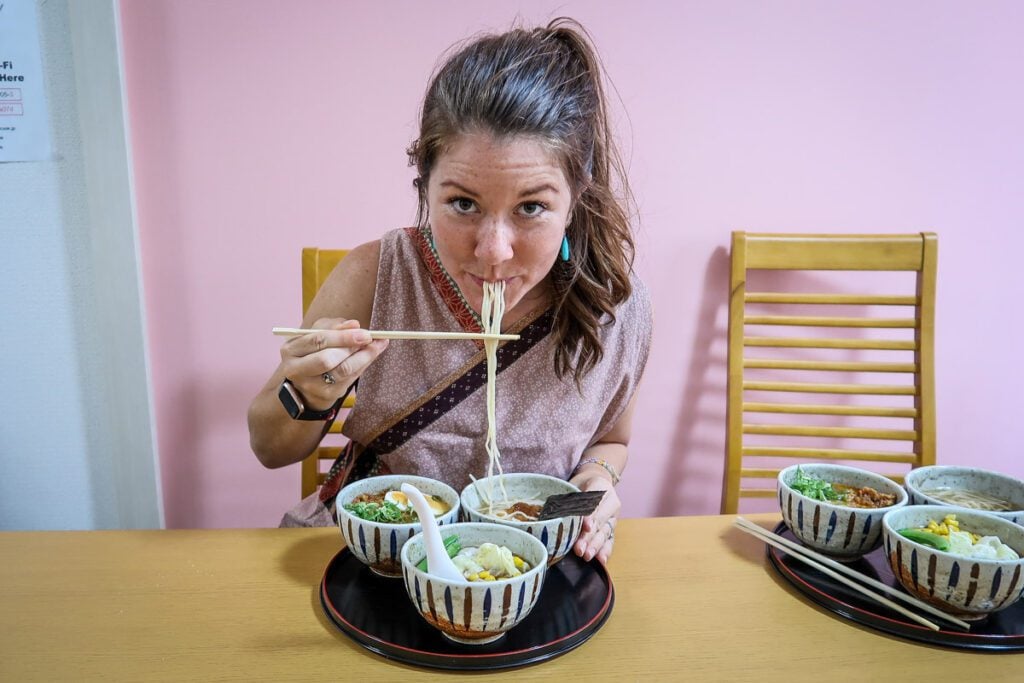
- Wander the colorful streets of Yokohama Chinatown while satisfying all your cravings for authentic Chinese food.
- Stroll through Sankeien Garden, a traditional Japanese garden with serene waterscapes, flowers, teahouses, and a pagoda.
- Explore Minato Mirai 21, aka “the harbor of the future”. This urban waterfront district is home to some of the city’s most iconic sights, such as the sky-scraping Landmark Tower, the Cosmo World Ferris Wheel, and the Yokohama Museum of Art.
- Good to know: the museum is currently closed for renovations and scheduled to reopen in March 2024.
- Board the NYK Hikawa Maru, a passenger ship turned floating museum that illustrates Yokohama’s maritime history.
- Tour the Kirin Beer Factory while learning about the brewing process through a variety of interactive exhibits and hands-on experiences.
- Shop and dine in the historic Red Brick Warehouse, a symbol of Yokohama’s port history with a variety of boutiques and restaurants. Head to the third floor balcony for sweeping harbor views.
- Make your own instant noodles at the Cupnoodles Museum. Design your own cup, then choose from a variety of soup flavors and toppings to create your own personalized product (and a unique souvenir to take home!).
- If you’re more of a noodle purest, try the Shin-Yokohama Ramen Museum instead to discover different regional styles of Japan’s beloved noodle dish.
How to get there
By train: There are a couple of trains you can take to Yokohama Station depending on where you’re staying in Tokyo. From Shinagawa Station, take the Keikyu Main Line – Limited Express Misakiguchi. Otherwise, take the Toyoko Line from Shibuya Station.
By car: Follow Route 1 south out of Tokyo all the way to Yokohama.
By guided tour: This new half-day tour from Get Your Guide includes pickup in Tokyo and a guide who will take you to both famous attractions and hidden gems in Yokohama.
5. Hakone
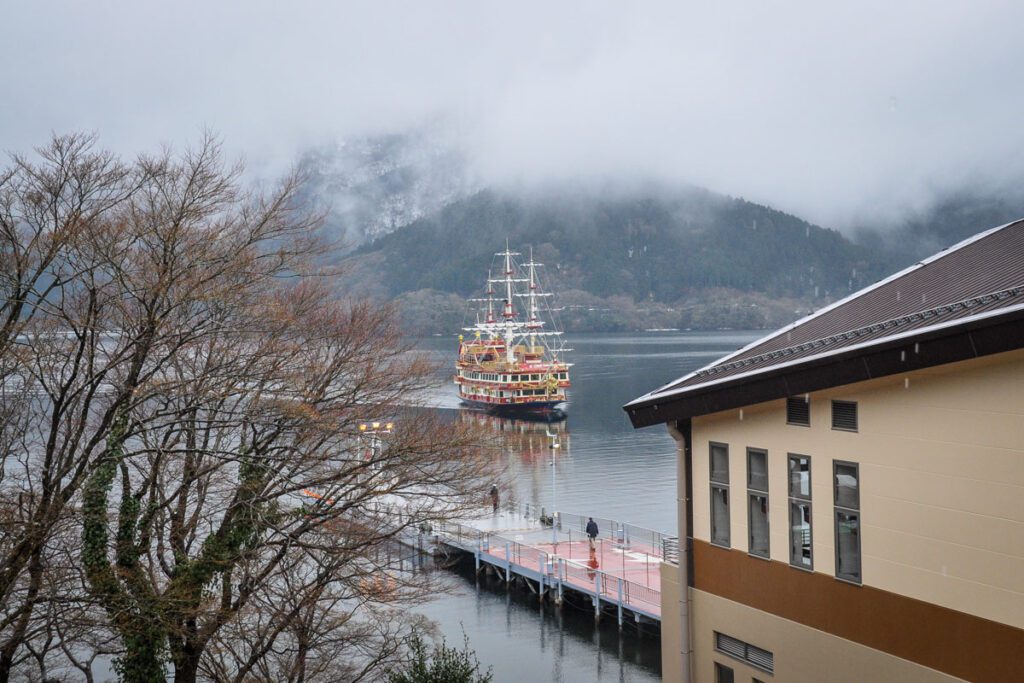
- At a glance: picturesque hot spring town with views of Mount Fuji
- Distance from Tokyo: 85.1 km / 52.9 miles
- Time: 1 hour 42 minute train ride / 1 hour 8 minutes driving
Nestled in the mountains on the shores of Lake Ashinoko, Hakone is known as a great place to view Mount Fuji. However, even if you aren’t able to glimpse the iconic mountain (all we saw was a sea of white clouds on our first visit), this small town still makes for a peaceful day trip from Tokyo.
Hakone is a renowned hot spring destination full of traditional Japanese guest houses called ryokan, many of which have therapeutic onsens that are open to the public. During our first trip to Japan in the winter of 2015, we took a steamy dip in the private onsen at Fuji-Hakone Guest House and relaxed with wine as snowflakes fell all around us. Talk about magical!
Insider tip: You may want to consider getting the Hakone Free Pass for your day trip. This is the most cost-effective package that includes all bus tickets in the area, as well as a lake cruise and a gondola ride.
Top things to do in Hakone
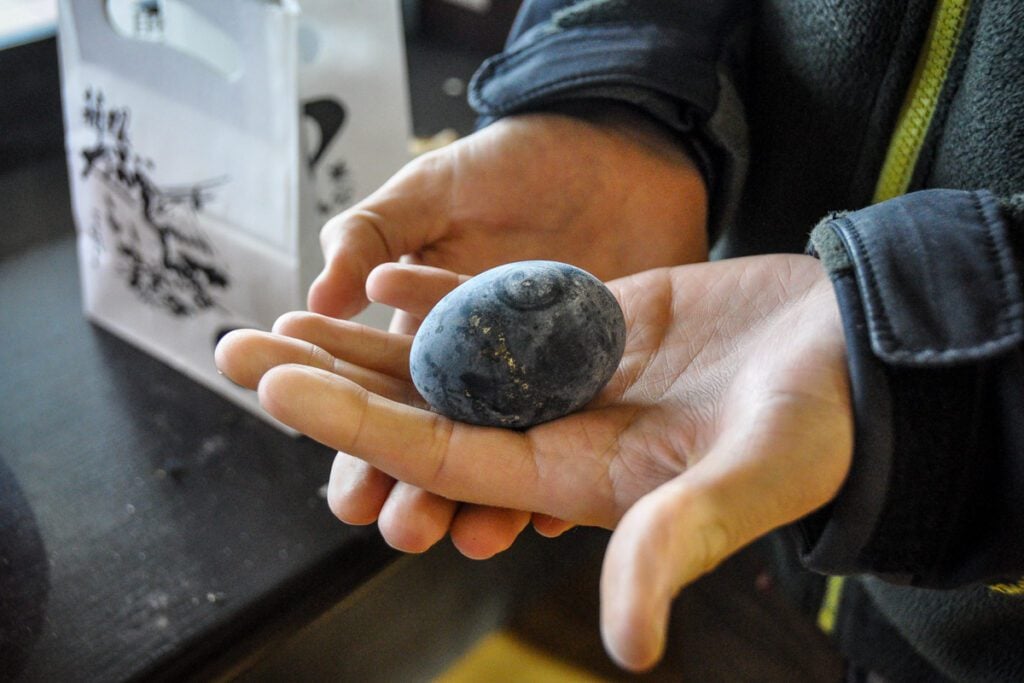
- Soak in one of Hakone’s many onsens. Try to find one that’s outdoors for a chance to see Mount Fuji.
- Before you start shedding your clothes, be sure to read up on proper onsen etiquette to avoid making any embarrassing mistakes.
- Explore the Hakone Open-Air Museum, where the natural environment is the setting of various sculptures and art installations.
- Eat a black egg in Owakudani. The eggs are boiled in the hot springs and legend says that eating one will add 7 years to your life.
- Cruise Lake Ashinoko on a pirate ship. This cheesy-but-fun tourist activity is a unique way to sightsee around the lake and is included in the Hakone Free Pass.
- Soar over volcanic landscapes on the Hakone Ropeway. The entire ropeway takes about 30 minutes and is included in the Hakone Free Pass. Enjoy panoramic views of the Owakudani Valley and, if you’re lucky, Mount Fuji. You might wanna hold your nose as you pass over the active sulphur fields!
- Good to know: Sections of the ropeway will be out of service for maintenance January – March, 2024. Full service is set to resume March 18.
- Discover Hakone Shrine, the region’s most important Shinto shrine. From the red torii gate standing in the waters of Lake Ashi to the buildings hidden in the deep forest, this picturesque shrine embraces its natural surroundings.
- Stroll through a sea of swaying pampas at Sengokuhara Susuki Grass Fields, a dreamy landscape that changes color with the seasons.
How to get there
By train: The simplest way to get to Hakone from Tokyo by train is to take the Limited Express Romancecar from Shinjuku Station to Hakone-Yumoto Station. This train, designed for sightseeing, costs ¥2,470 (about $17.50 USD) and is not included in the Hakone Free Pass.
Alternatively, if you have the JR Pass you can use it to get as close as Odawara Station, then use the Hakone Free Pass from there. There are no JR lines within the Hakone region.
By car: Take Route 3 southwest out of Tokyo onto the Tomei Expressway (E1). At the Atsugi Interchange, get on Route 271 and continue until Odawara-nishi Interchange. Then follow Route 1 to Hakone city center.
By guided tour: This bus tour from Get Your Guide includes a pirate ship cruise on Lake Ashinoko as well as a gondola ride up Mount Hakone, finishing with your choice between shopping at the Gotemba Premium Outlets or relaxing in an onsen.
6. Arakurayama Sengen Park
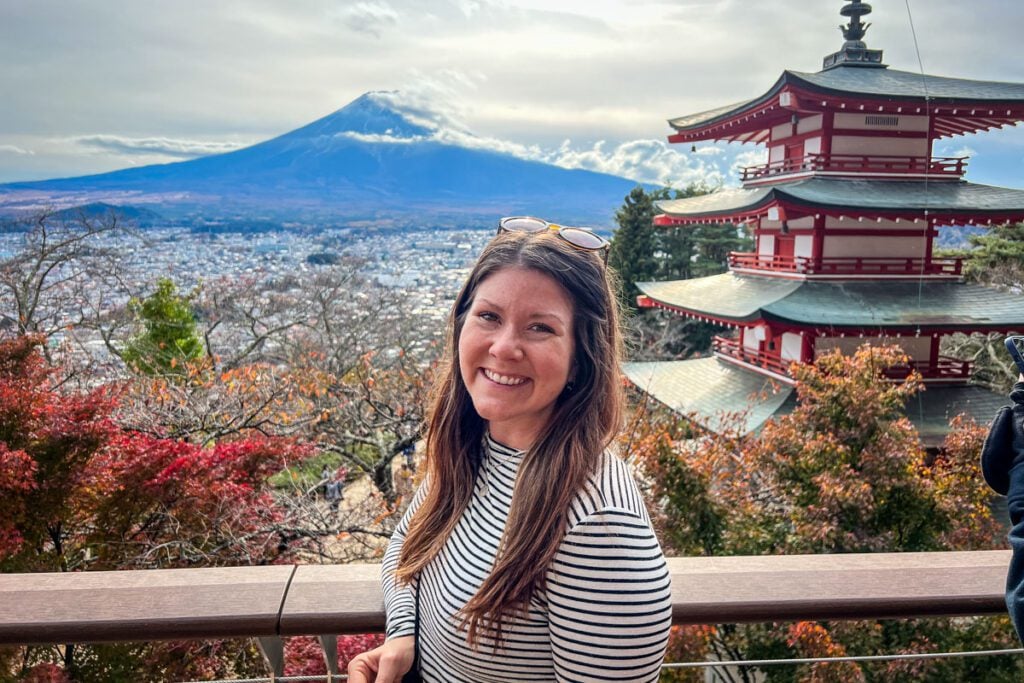
- At a glance: postcard views of Chureito Pagoda and Mount Fuji
- Distance from Tokyo: 108 km / 67 miles
- Time: 2.5 hour train ride / 1 hour 25 minutes driving
Located in Fujiyoshida not far from Tokyo, Arakurayama Sengen Park is celebrated as one of the best places to view and photograph Mount Fuji.
This is where you get that postcard-perfect shot – you know the one I’m talking about. The vermillion 5-tiered pagoda (it’s called Chureito Pagoda, if you didn’t know) rising out of a sea of pink and white cherry blossoms, set against the backdrop of Japan’s most iconic peak.
That’s the dream, anyway.
Of course, the reality is that you’ll be bumping elbows with hordes of other tourists (especially during sakura season), and you may not even see Mount Fuji, who is notoriously shy and likes to hide behind clouds.
I’m not saying all this to be a downer or to dissuade you from going, but to help you manage your expectations. The first time we tried to see Mount Fuji, all we got was a seemingly solid wall of white clouds. But on our most recent trip to Japan, we got super lucky and had several days of clear Fuji views. You just never know!
Top things to do in Arakurayama Sengen Park
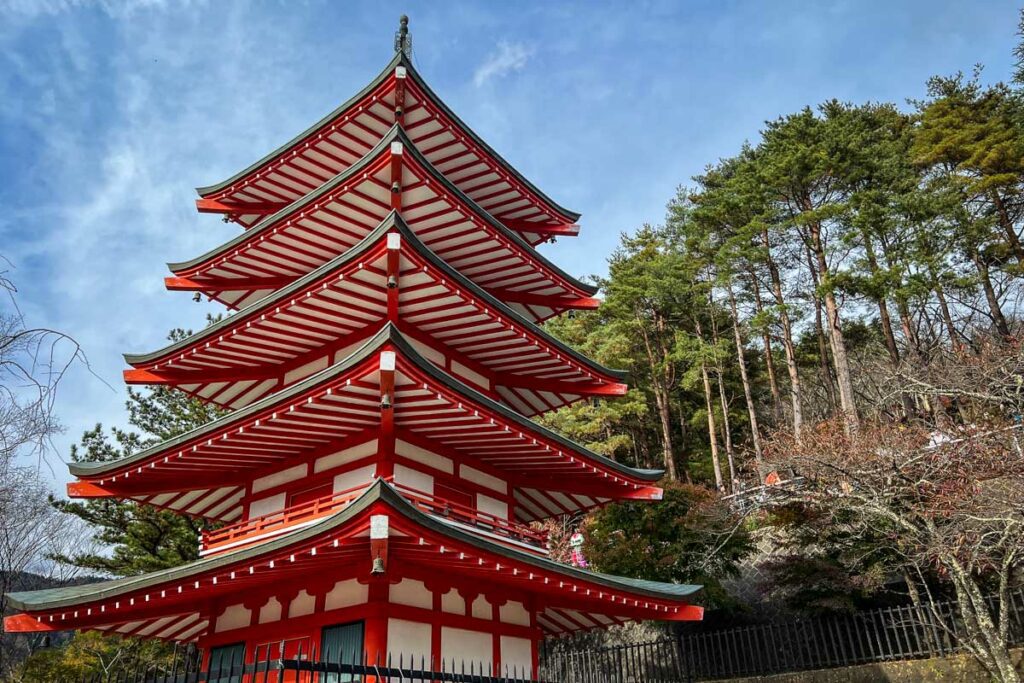
- Climb 398 steps to the observation deck for the best views.
- Capture iconic photos of Chureito Pagoda with Mount Fuji in the background.
- Witness seasonal foliage, such as cherry blossoms in the spring and fiery red Japanese maples in the fall.
- Admire Arakura Fuji Sengen Shrine.
- Hike the forested Gongon-ishi trails.
How to get there
By train: Take the Chuo Line from Shinjuku to Shimoyoshida Station. From there, you can either take a local bus or walk about 20 minutes to Arakurayama Sengen Park.
By car: Follow Route 4 westbound out of Tokyo. At Takaido Interchange, get on Chuo Expressway (E20) and continue until Otsuki Interchange. Turn onto Kawaguchiko Rte (E68), then exit at Fujiyoshida-Nishikatsura Smart Interchange.
By guided tour: Arakurayama Sengen Park is included in this full-day sightseeing tour from Tokyo, as well as other famous landmarks in the Fujisan area.
7. Hitachi Seaside Park
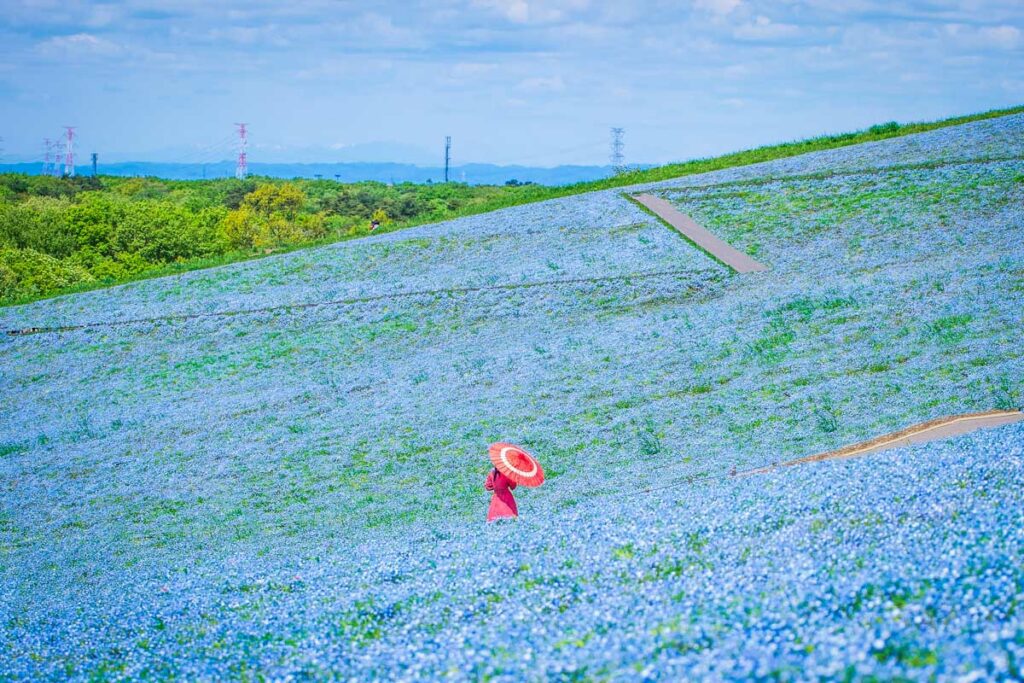
- At a glance: sweeping fields of colorful flowers
- Distance from Tokyo: 126 km / 78.3 miles
- Time: 1 hour 54 minute train ride / 1 hour 27 minutes driving
Situated in Ibaraki Prefecture northeast of Tokyo, Hitachi Seaside Park covers the slopes of Japan’s Pacific coast with millions of flowers that bloom year-round.
The park’s most iconic flower is nemophila, whose delicate sky-blue petals carpet Miharashi Hill around late-April to mid-May. On a clear day, the sky, sea, and flowers together create a 360-degree periwinkle panorama.
Spring also brings yellow and white narcissus, rows of colorful tulips, poppies, and roses. Summer blooms include sunflowers and zinnia, while the fluffy, rounded kochia bushes display a vivid lime green.
Moving into fall, the kochia gradually turn a vibrant shade of scarlet while cosmos explode in pinks and oranges. Even winter has its blooms with ice tulips and Japanese plum trees.
In addition to flowers, Hitachi Seaside Park features a small amusement park with a giant ferris wheel, a few other retro rides, and a putt-putt golf course, making it a great day trip for families.
Top things to do in Hitachi Seaside Park
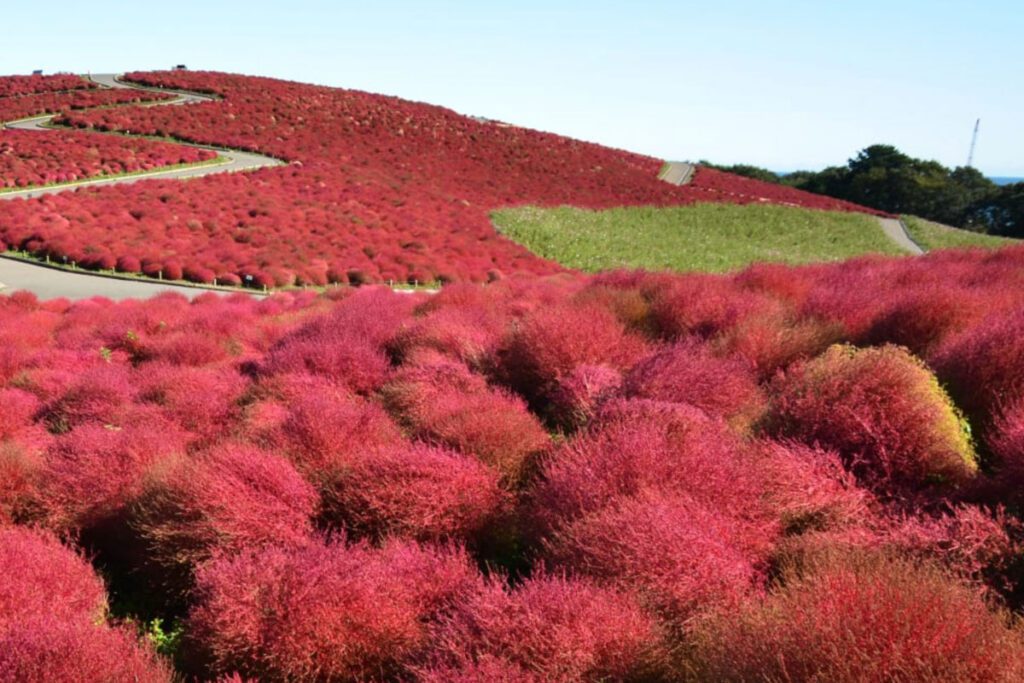
- Stop and smell the flowers. Check the park’s flower calendar to see what will be blooming during your visit.
- Admission ranges from ¥450-700 (about $3-5 USD) depending on the season.
- Rent a bicycle and explore the park’s expansive grounds on two wheels. There are separate paths for walking and cycling throughout the park for added safety and comfort.
- Take a spin on the giant ferris wheel and enjoy panoramic views of both the park and the Pacific Ocean.
- Play a round of putt-putt golf on the 36-hole course.
How to get there
By train: From Ueno Station, take the Hitachi and Tokiwa train to Katsuta Station, then catch a local bus to Hitachi Seaside Park.
By car: Take Route 6 northbound out of Tokyo, continuing onto Joban Expressway (E6). At Tomobe Junction, get on the Kita Kanto Expressway (E50) and follow to Hitachi Seaside Park.
By guided tour: Hitachi Seaside Park is the final stop on this day trip from Tokyo, which also includes Oarai Isosaki Shrine and Nakaminato Fish Market.
8. Lake Kawaguchi
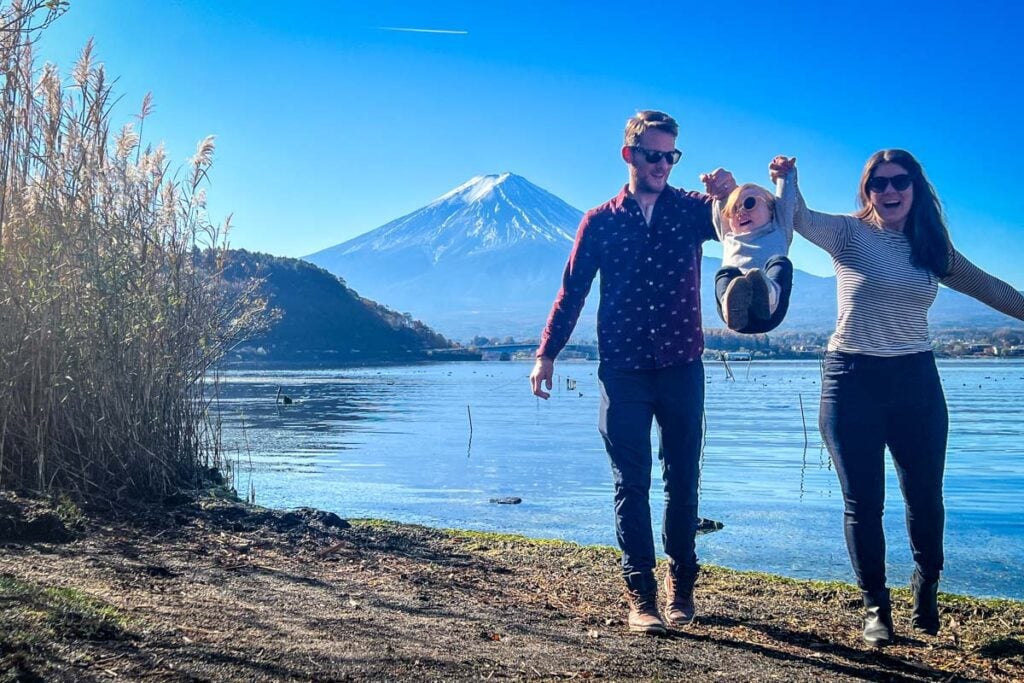
- At a glance: water activities and scenic views at the foot of Mt. Fuji
- Distance from Tokyo: 114 km / 70.8 miles
- Time: 2 hour 35 minute train ride / 1 hour 28 minutes driving
The most accessible of the Fuji Five Lakes, Lake Kawaguchi is undoubtedly one of the most popular places to view and photograph Mount Fuji. The serene waters of the lake reflect the iconic peak within a frame of seasonal foliage, changing from cherry blossoms in the spring to crimson maple leaves in the fall.
Even if you aren’t lucky enough to see Mount Fuji, a day trip to Lake Kawaguchi promises a relaxing break from the big city with plenty of opportunities to enjoy the area’s natural beauty.
Top things to do in Lake Kawaguchi
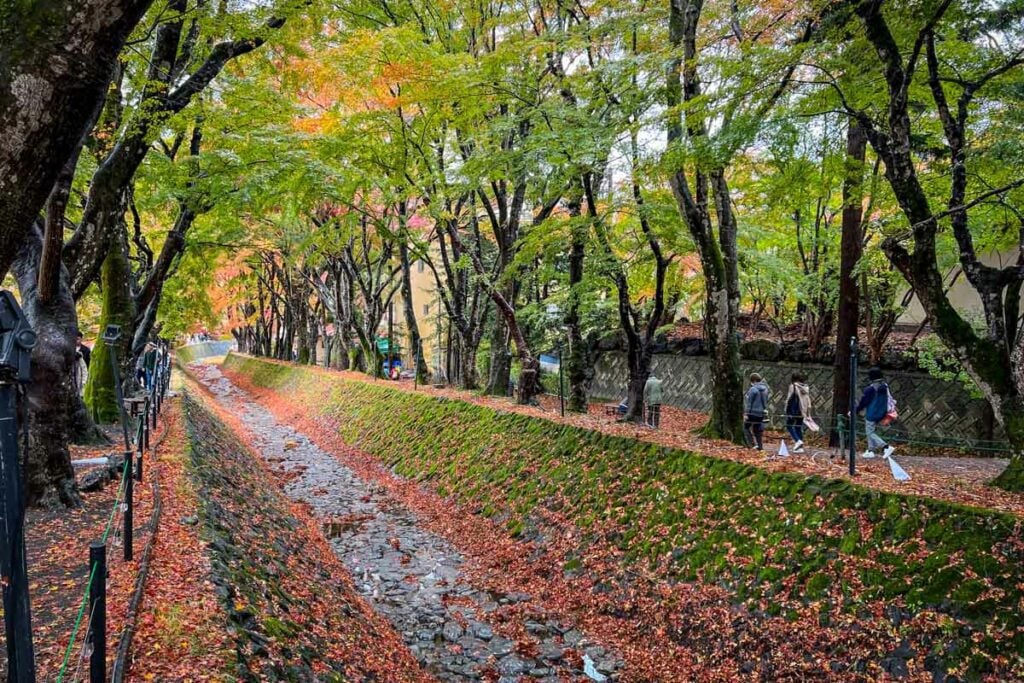
- Snap a postcard-worthy photo of Mount Fuji from the northern shore of the lake.
- Cruise Lake Kawaguchi for a unique perspective of Mount Fuji and the surrounding landscapes.
- Ride the Kachi Kachi Ropeway for panoramic views of Lake Kawaguchi and Mount Fuji.
- Visit Kubota Itchiku Art Musuem to see a breathtakingly impressive collection of kimonos (trust me, it’s worth it!). The gardens on the ground are stunning and the onsite teahouse is a nice place to relax with a matcha set.
- Discover the Kawaguchiko Music Forest, a museum that houses antique music boxes and other mechanical instruments set amongst beautiful European-style gardens.
- Photograph the Momiji Corridor in autumn, when the Japanese maples lining the canal display vivid shades of red and gold and fallen leaves carpet the ground.
- Good to know: This location is different from the Momiji Tunnel, which is a popular spot to photograph Mount Fuji.
- Make your own jam at the Kawaguchiko Natural Living Center. This family-friendly experience is located in Oishi Park, a prime Mount Fuji viewing spot. The center also offers a couple of cafes, a handful of shops, and fruit picking in the summer.
- Relax in an onsen with a view. Lake Kawaguchi has plenty of hot springs to choose from for a steamy soak.
How to get there
By train: Take the Chuo Line from Shinjuku to Kawaguchiko Station, then catch a local bus to the lake.
By car: Follow Route 4 westbound out of Tokyo. At Takaido Interchange, get on Chuo Expressway (E20) and continue until Otsuki Interchange. Turn onto Kawaguchiko Rte (E68). At Kawaguchiko Interchange, get on Route 139 westbound, then turn right onto Route 707.
By guided tour: This day trip from Tokyo includes stops at Arakurayama Sengen Park (#6 on this list), the Kawaguchiko craft park, Oishi Park, and finally the traditional village of Saiko Iyashi no Sato Nenba.
9. Akiruno
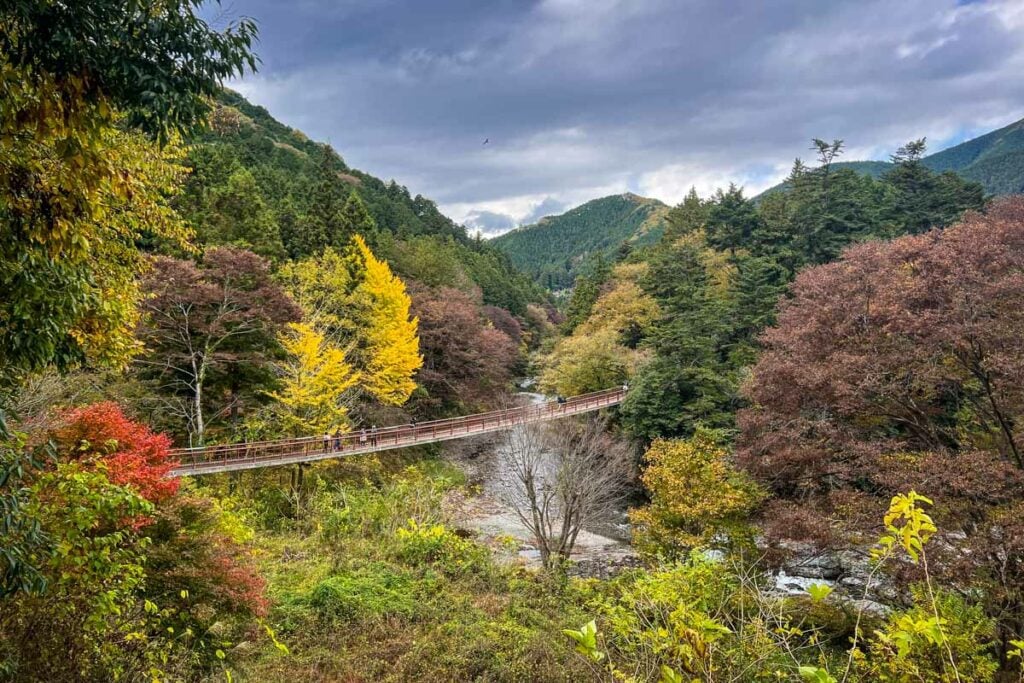
- At a glance: scenic escape with lush greenery and quirky attractions
- Distance from Tokyo: 52.5 km / 32.6 miles
- Time: 1 hour 4 minute train ride / 50 minutes driving
Located within the Tokyo Metropolitan area, Akiruno is one of the most accessible day trips from Tokyo. But with peaceful temples and fairytale forests dotted around the meandering Aki River, it couldn’t feel further from the neon and steel of the big city.
“Aki” is Japanese for “autumn”, so it’s no surprise that fall is considered the best time to visit. The momiji (Japanese maple) and gingko trees in the Akigawa Valley, ablaze with shades of red and gold, create a brilliant tapestry of color.
But there’s also a case to be made for early summer, when 10,000 hydrangeas burst to life on the forested slopes of Minamisawa Ajisai Mountain. Paths weave through the pink and blue flowers beneath towering cedar trees, creating a magical atmosphere.
Top things to do in Akiruno
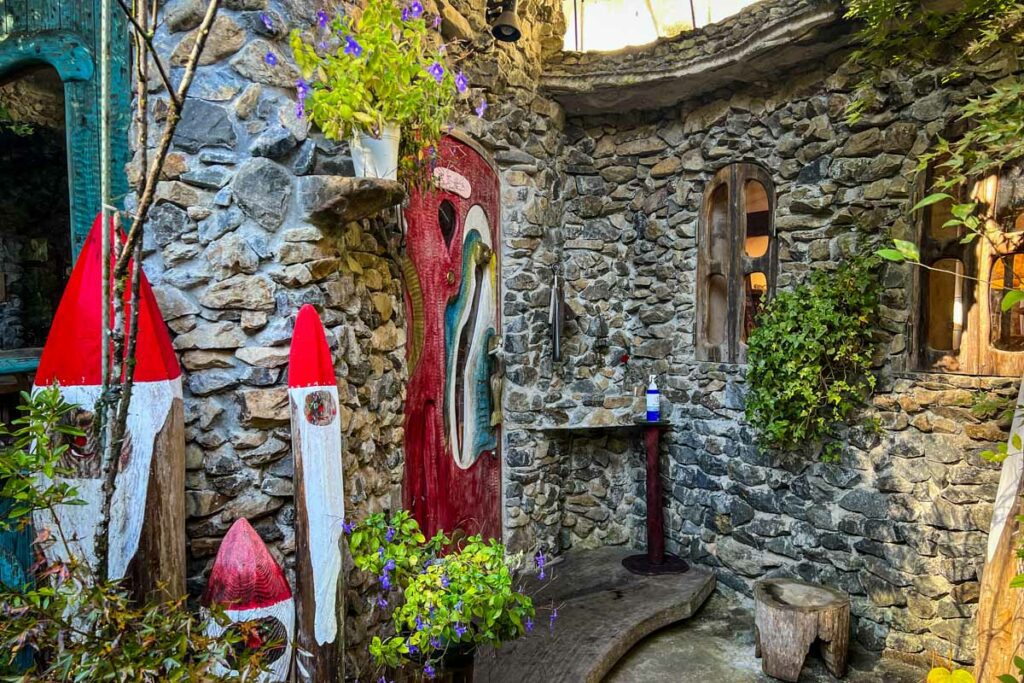
- Witness the captivating fall foliage of the Akigawa Valley.
- Walk across Ishibune Bridge, a 96-meter (315 ft) footbridge over the Akigawa River that provides panoramic views of the scenic gorge.
- Sip a hot drink at the Fukuzawa Tiny Museum. They only serve black coffee and tea, but we loved visiting this quirky little cafe, owned by a sweet couple and filled with the husband’s whimsical art. There’s a lovely garden with a koi pond out back and, as a bonus, we had the place all to ourselves!
- Cuddle adorable pigs at Pignic Farm & Cafe. (pictured below)
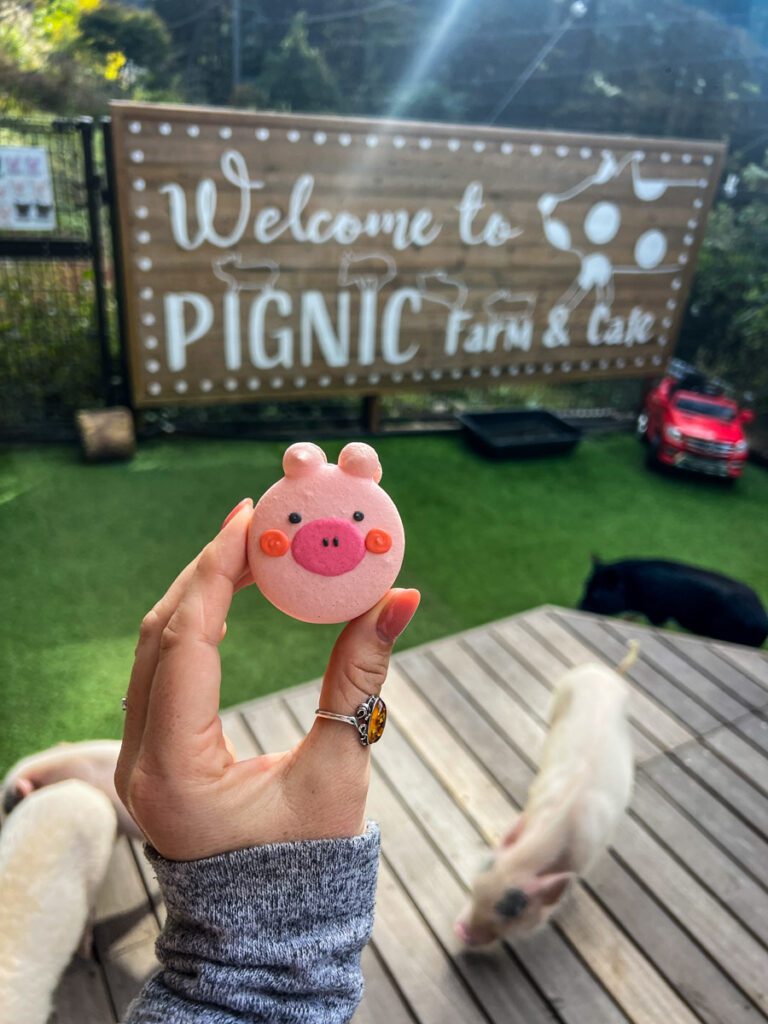

- Visit Kotokuji Temple, known for its moss-covered gate and gingko trees that surround the temple in a canopy and carpet of golden leaves in the fall.
- Wander the magical hydrangea mountain. Minamisawa Ajisai Mountain is named after Chuichi Minamisawa, locally known as Chichuan, an elderly gentleman who has single-handedly been planting hydrangeas on the mountain for 50 years.
- Good to know: the hydrangeas bloom in mid-June to early July. During hydrangea season, there is a ¥600 ($4.15 USD) entry fee. No parking is available and visitors are asked not to bring a vehicle.
- Explore Odake Limestone Cave, a 300-meter (984 ft) subterranean gallery of natural rock formations beneath a sacred mountain.
- Grab some really good coffee in a cute atmosphere at POUND.
- Indulge in a memorable kaiseki lunch at Kurochaya, which is a centuries-old house with a stunning riverside setting. You may want to make reservations. Alternatively, if it’s too busy, you can grab some items to go and enjoy next to the water, like kakigori (shaved ice) in the summer.
How to get there
By train: Take the Chuo Line from Shinjuku to Haijima Station, then catch a local bus to Akiruno.
By car: Take Route 4 westbound out of Tokyo to Takaido Interchange and get on Chuo Expressway (E20). At Hachioji Interchange, follow signs for Central Hachioji/Akishima. Turn right at Tanino Kaido intersection onto Route 166. Make a left onto Route 169, following signs to your destination.
10. Wine country: Yamanashi Prefecture
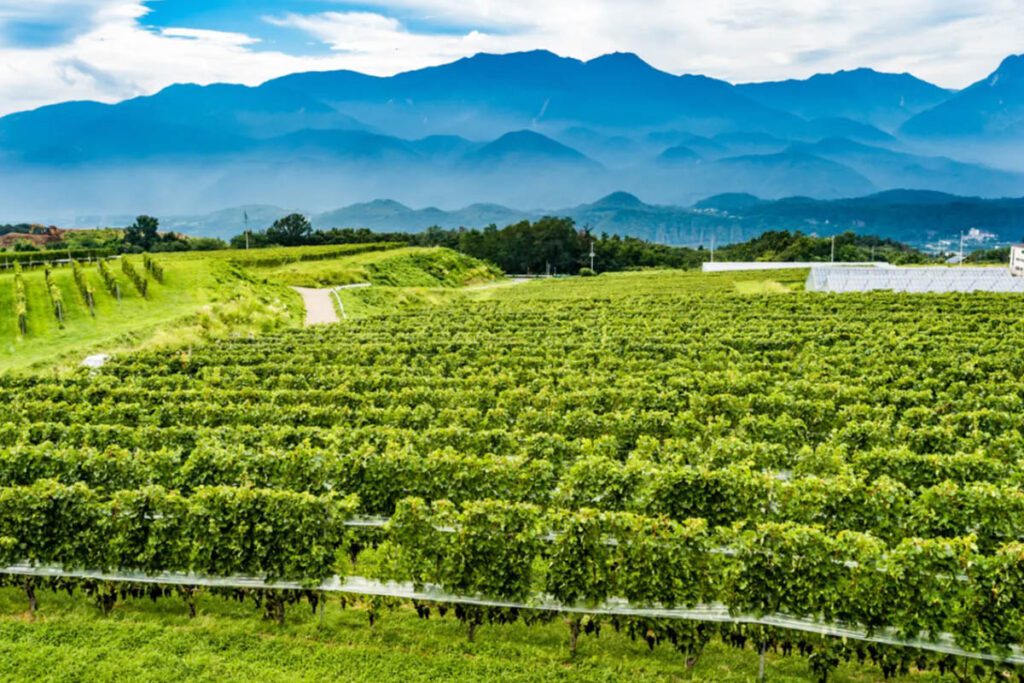
- At a glance: rolling vineyards and serene lakes with Mt. Fuji views
- Distance from Tokyo: 121 km / 75.2 miles
- Time: 1 hour 18 minute train ride / 1 hour 13 minutes driving
When you hear “wine country”, you probably think of France, Italy, Napa, maybe New Zealand… but I’m betting Japan doesn’t come to mind, right?
Well as it turns out, Japan actually has its own wine country in Yamanashi Prefecture, just west of Tokyo.
It’s known as Japan’s “fruit kingdom”, and it’s easy to see why. Not only does Yamanashi produce more grapes, peaches, and plums than anywhere else in the country, they also grow cherries, persimmons, pears, apples, kiwi, and strawberries.
At the heart of Yamanashi is the Kofu Basin, a sunny valley encircled by mountains. Conditions in the basin are just right for vineyards, including a unique local specialty, the Koshu grape.
But if you’re not a wino, don’t scroll away just yet – the Kofu Basin is also known for its abundance of pure, fresh water, which is used to make high-quality sake, whiskey, and craft beer in addition to wine.
Oh, and did we mention a lot of the wineries have views of Mount Fuji?!
Top things to do in Yamanashi Prefecture
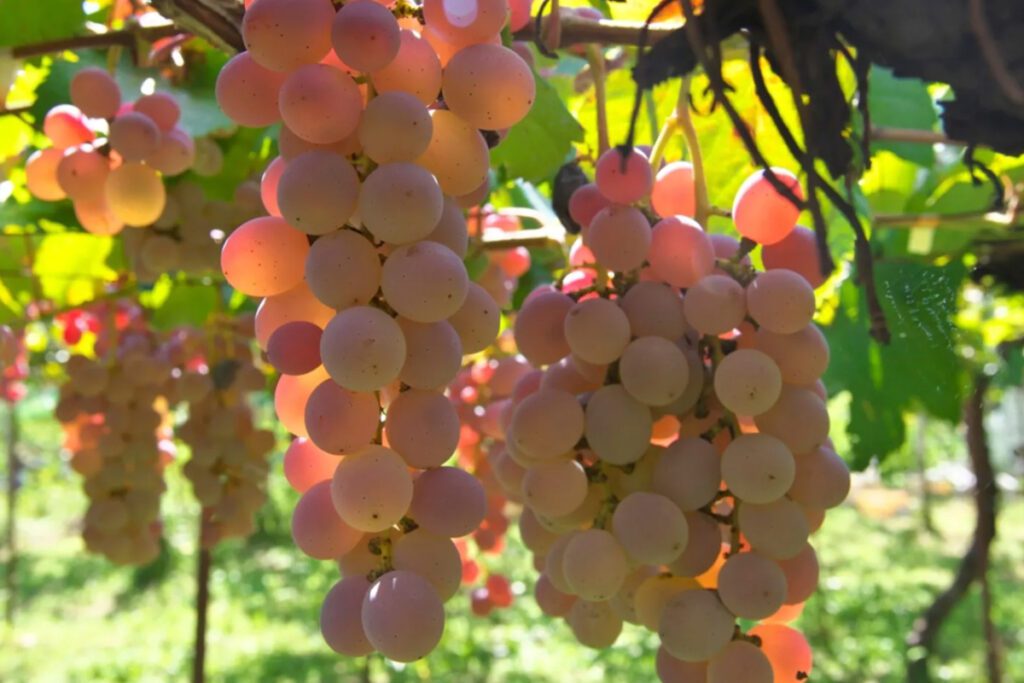
- Go wine tasting in Katsunuma. There are around 40 wineries to choose from in Katsunuma alone, but Chateau Mercian is one that offers tours in English, as well as a tasting room and a wine museum.
- Pick fruit in an orchard and enjoy seasonal produce as fresh as it gets.
- Soak in a unique onsen, such as the fruit-infused hot springs at Fruit Spa PukuPuku, or the public baths with spectacular Mount Fuji views at Hottarakashi Onsen.
- Admission fees for both are around ¥900-1,000 (less than $7 USD).
- Visit Daizenji Temple. Nicknamed “Grape Temple”, this is a fitting historic site to add to your wine country itinerary. Daizenji overlooks the Kofu Plain from its position on a hillside covered with vineyards, and it houses a statue of a grape-bearing Buddha.
- Hike to Nanatsugama Godan Falls, a spectacular 5-tiered turquoise waterfall in the Nishizawa Valley of Chichibu-Tama-Kai National Park. This loop takes about 3.5 hours to complete and could be done on a day trip.
How to get there
By train: From Shinjuku Station, take the Chuo Line to Enzan Station in Koshu. The express trains are the fastest, but are expensive if you don’t have the JR Pass. The regular train takes about 30 minutes longer, but costs about half as much.
By car: It’s a straightforward drive from Tokyo to Katsunuma in Yamanashi Prefecture via the Chuo Expressway (E20).
11. Chichibu
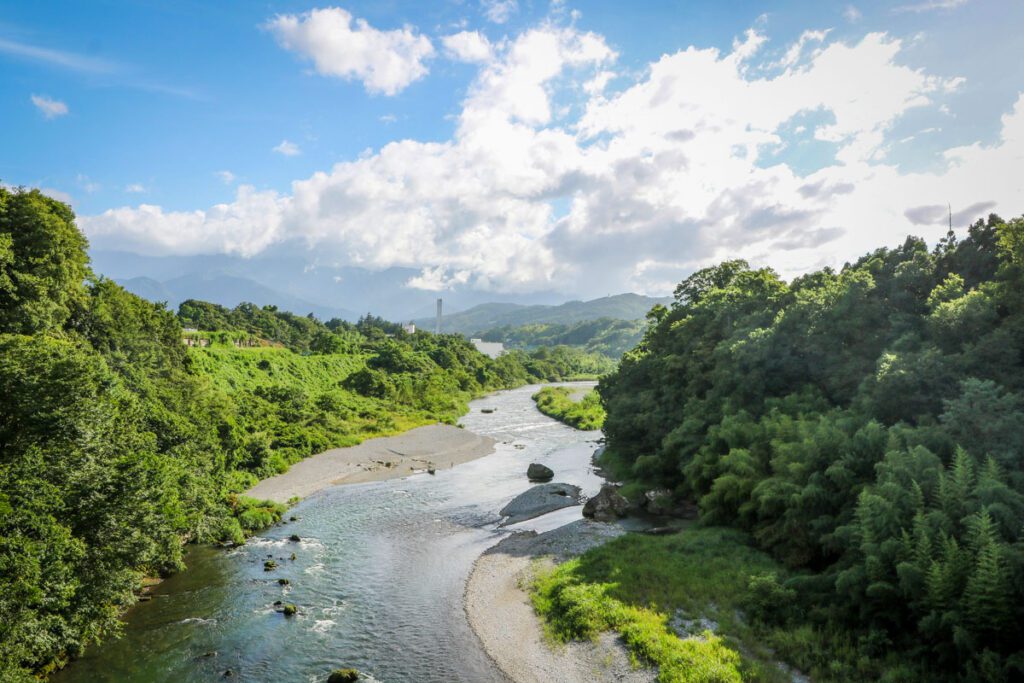
- At a glance: nature, culture, and outdoor adventures surrounded by mountains
- Distance from Tokyo: 109 km / 67.7 miles
- Time: 2 hour 4 minute train ride / 1 hour 41 minutes driving
Surrounded by densely forested mountains, intersected by the meandering Arakawa River, and neighbored by a national park, the picturesque town of Chichibu is a treasure trove of outdoor adventure within reach of the city.
Each season has something different to offer, from springtime blooms to dazzling winter ice formations, and the Nakatsu Valley is considered one of the 100 best places in Japan to see fall foliage.
Top things to do in Chichibu
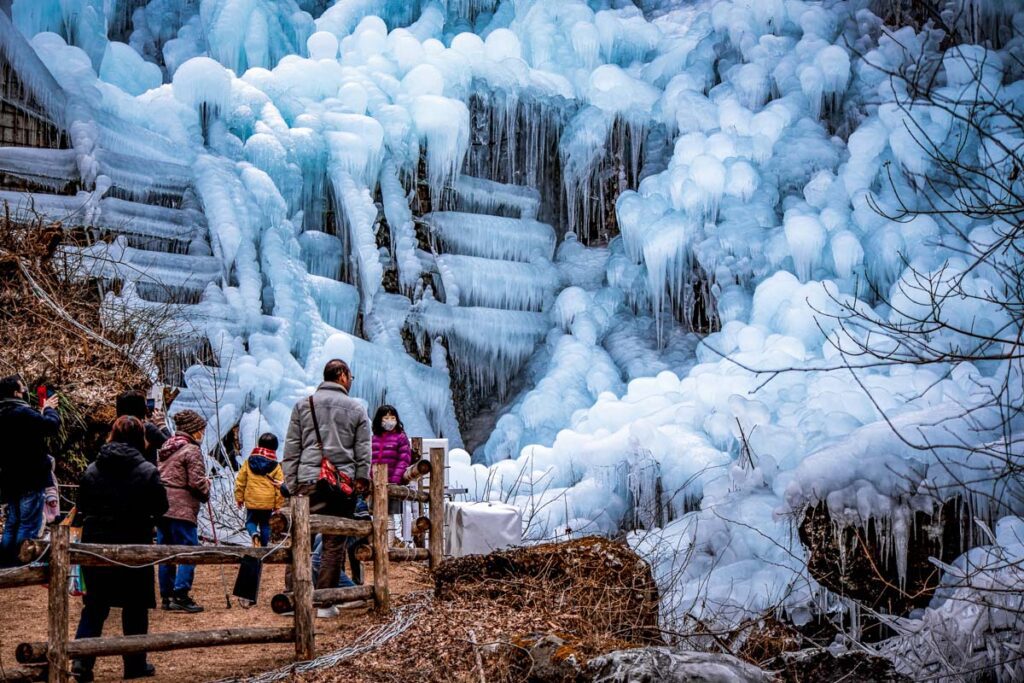
- Travel through the Nakatsu Valley in autumn to see the 10-kilometer (6.2 mile) long valley alight with fiery fall foliage.
- Get your adrenaline pumping at Chichibu Geo Gravity Park. Soar high above the Arakawa River on a zipline, plunge into the abyss with a bungee jump, or try the canyon walk or swing.
- Go whitewater rafting in nearby Nagatoro. This company offers tours in English.
- See the shibazakura (moss phlox) in bloom. In late spring, Hitsujiyama Park becomes a sea of vibrant fuschia, magenta, and white flower gardens laid out in elaborate designs.
- Try the shaved ice at Asami Reizou. Customers queue up at this shop in Nagatoro for a chance to try the famous dessert, made from ice harvested outside in the winter and flavored with natural toppings.
- Marvel at the Icicles of Misotsuchi, a natural phenomenon that only appears in the coldest weeks of the year when mountain runoff freezes over a rock wall.
- Attend Chichibu Yomatsuri in early December. The famous Night Festival includes a parade of illuminated floats, a 2-hour fireworks display, and tons of street food.
- Walk part of the Chichibu Pilgrimage Circuit, a historic route connecting 34 temples across the county. Chichibu Tourism offers a recommended day trip route on their website here.
- Visit Mitsumine Shrine, a Shinto site dedicated to sacred mountain wolves. Sadly, the Japanese wolf is now extinct, but the shrine offers a serene woodland atmosphere and impressive mountain views.
How to get there
By train: From Ikebukuro Station, take the Seibu Ikebukuro Line Limited Express to Seibu-Chichibu Station.
By car: Follow Kan-etsu Expressway (E17) heading northwest out of Tokyo. At Hanazono Interchange, get on Route 140 and continue to Chichibu.
12. Mt. Nokogiri
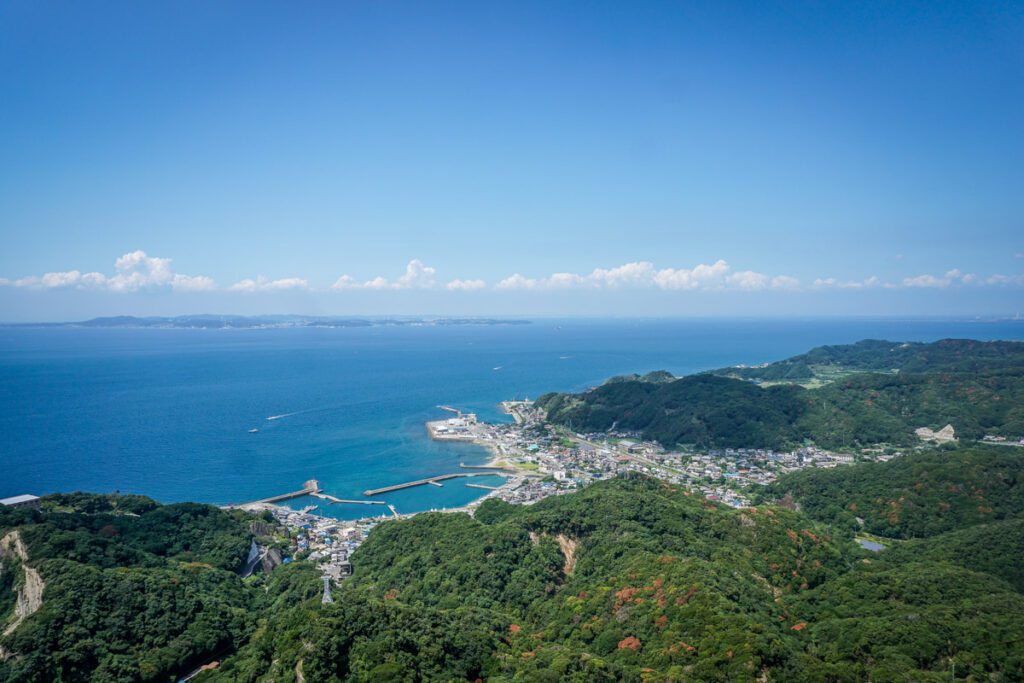
- At a glance: captivating rock formations and Buddhist temple with views of Tokyo Bay
- Distance from Tokyo: 80 km / 49.8 miles
- Time: 2 hour 21 minute train ride / 56 minutes driving
On the west coast of the Boso Peninsula in Chiba Prefecture, Mt. Nokogiri looms 329 meters high (1,079 feet) over the small seaside towns of Kanaya and Hota.
Nokogiriyama translates to “saw mountain”, named for its jagged, rocky ridgeline that resembles the teeth of a saw. Below the ridgeline, sheer, vertical cliffs of bare granite drop dramatically into lush forest.
Networks of hiking trails, panoramic viewpoints, and a large temple complex make Mt. Nokogiri well worth a day’s exploration.
If you’re driving, there is a toll road off Route 127 on the outskirts of Hota with parking near the summit. Otherwise, you can take the ropeway from Kanaya or ascend on foot via some-2,639-odd steps.
Top things to do in Mt. Nokogiri
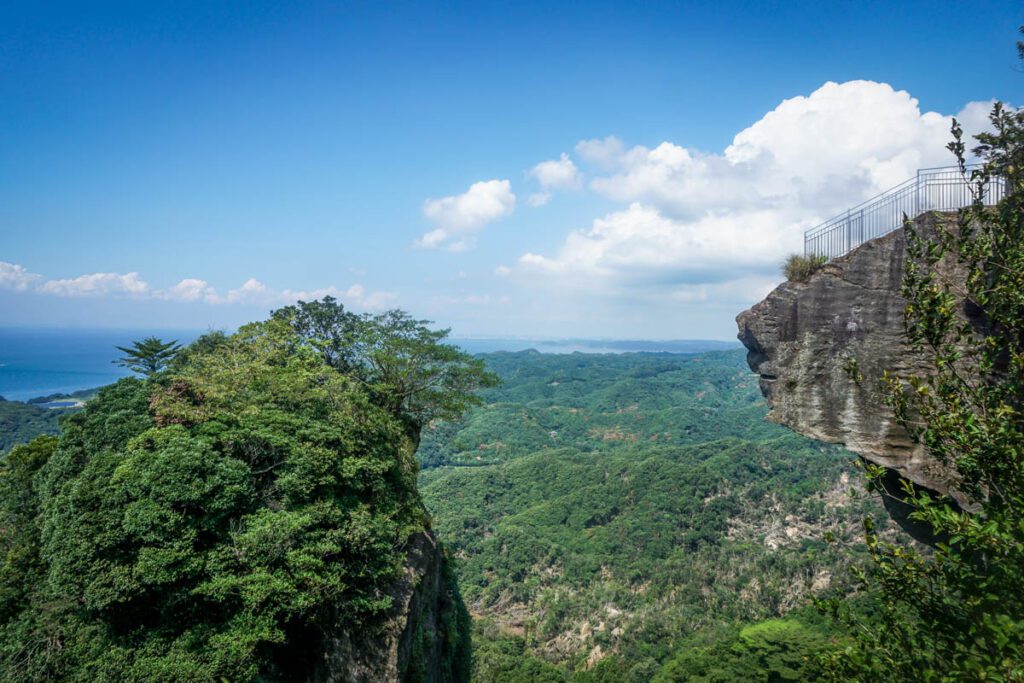
- Test your nerve at Jigoku Nozoki, aka “Hell Peek Point”. One of the highest lookouts in Chiba Prefecture, visitors queue up to feel the thrill of peering straight down into the abyss from a rock that juts over the edge of the cliff.
- Explore the grounds of Nihonji Temple. This 1,300-year-old complex encompasses the entire upper part of the mountain, dotting the slopes with sites connected by a network of walking paths.
- Good to know: there is an admission fee of ¥700 ($4.85 USD) to enter the temple grounds, which includes all mountaintop landmarks.
- Marvel at the giant granite Buddha statue, one of the largest in Japan.
- See the towering goddess Hyaku-Shaku Kannon carved into a sheer wall of granite.
- Fun fact: the name “Hyaku-Shaku” describes the height of the statue – 30 meters (almost 100 feet).
- Look for the smaller rakan statues. There are hundreds of carvings of Buddha’s disciples scattered throughout the temple grounds, tucked away in caves and crevices.
- Ride the Nokogiriyama Ropeway. Enjoy panoramic views on a quick ride to the summit. On a clear day, you can see as far as Mount Fuji and Tokyo Skytree from Nokogiriyama.
- Fee: ¥650 one-way or ¥1,200 round-trip ($4.50 / $8 USD)
How to get there
By train: To get to Mt. Nokogiri from Tokyo, you can either take the train around the edge of Tokyo Bay, or take a bus across. Despite the bus route being more direct, both take about the same amount of time.
By car: The quickest driving route from Tokyo to Mt. Nokogiri is via the Tokyo Wan Aqua Tunnel which runs under Tokyo Bay. Continue on the expressway to Kisarazu Junction, then turn onto Tateyama Expressway (E14) toward Tateyama. At Kisarazu-minami Junction, keep left to continue south on E14 to your destination.
13. Kawagoe
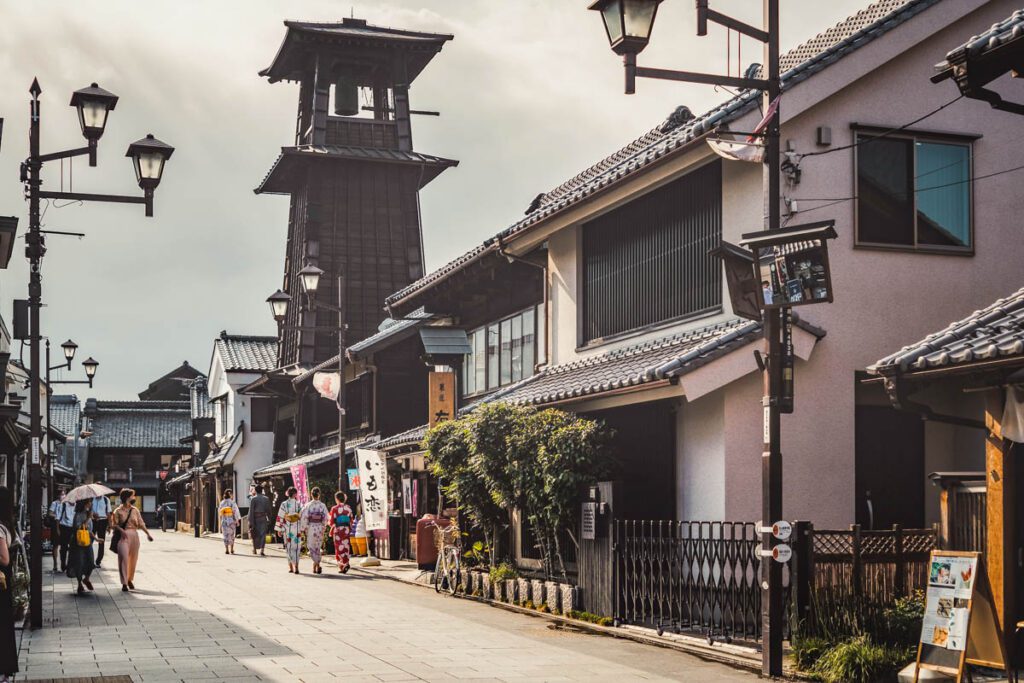
- At a glance: historic charm, Edo-period architecture, and cultural attractions
- Distance from Tokyo: 35.4 km / 22 miles
- Time: 25 minute train ride / 46 minutes driving
The city of Kawagoe in Saitama Prefecture is often referred to as “Koedo”, which translates to “Little Edo”.
Wandering the streets lined with Edo-period architecture housing traditional shops and eateries, you might feel like you’ve stepped back in time. A nostalgic and enchanting atmosphere pervades the streets, like a living museum.
As you explore, be sure to try a sweet potato snack or two. This local specialty can be found in just about everything, from ice cream to craft beer.
Top things to do in Kawagoe
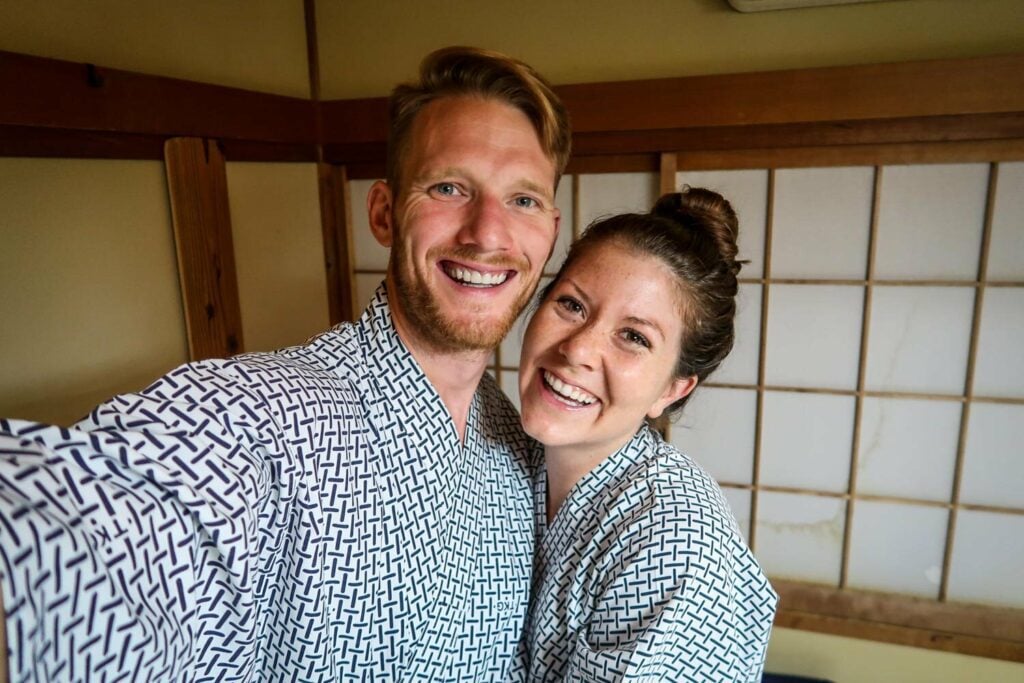
- Visit Kitain Temple and see the only remaining buildings of Edo Castle. The buildings were moved to Kawagoe from Edo (now Tokyo) in the mid-17th century. The rest of the castle was subsequently destroyed, along with much of Tokyo, in earthquakes and bombings.
- Explore Kurazukuri no Machinami, a street lined with traditional merchant-style warehouses with clay walls displaying Edo-period architecture.
- Sample sweets in Candy Alley (Kashiya Yokocho), a narrow street known for its traditional Japanese confectionery shops.
- Hear the bell ring at Toki no Kane, a 16-meter (52.5 ft) wooden bell tower that translates to “bell of time”. The bell rings daily at 6 a.m., noon, 3 p.m., and 6 p.m.
- Wear kimono or yukata. Vivian is a highly-rated rental shop that isn’t too expensive and will hold on to your luggage (except any valuables) while you walk around in your kimono.
- Women’s rental: ¥2,200 (~$15 USD)
- Men’s rental: ¥3,300 (~$23 USD)
- Couples’ rental: ¥4,950 (~$34 USD)
- Learn your fortune at Hikawa Shrine. Love is in the air at this enchanting Shinto shrine where 4 of the 5 enshrined deities are married couples. There are several ways to enjoy the site:
- Use a small fishing rod to catch a red snapper charm with your omikuji (fortune) attached, and keep the charm as a cute souvenir.
- If you’re looking for love, purchase a red pencil. It’s said that as the pencil gets smaller with use, so too does the distance between you and your destined match.
- Stroll through the Ema Tunnel, where more than 30,000 wooden prayer plates express their thanks and wishes.
- Listen to the peaceful melodies of wind chimes that decorate the shrine in summer.
- Have unaju for lunch, a popular local dish of broiled eel served over rice.
- Drink craft beer at the Coedo Brewery. A unique one to try is Beniaka, an imperial amber ale brewed with roasted Saitama sweet potatoes.
How to get there
By train: From Ikebukuro Station, take the Tobu-Tojo Line 23 Rapid-Liner Ogawamachi to Kawagoe Station.
By car: It’s a straightforward drive from Tokyo to Kawagoe via the Kan-etsu Expressway (E17). At the Kawagoe Interchange, exit onto Route 16 toward Kawagoe/Sayama.
14. Karuizawa
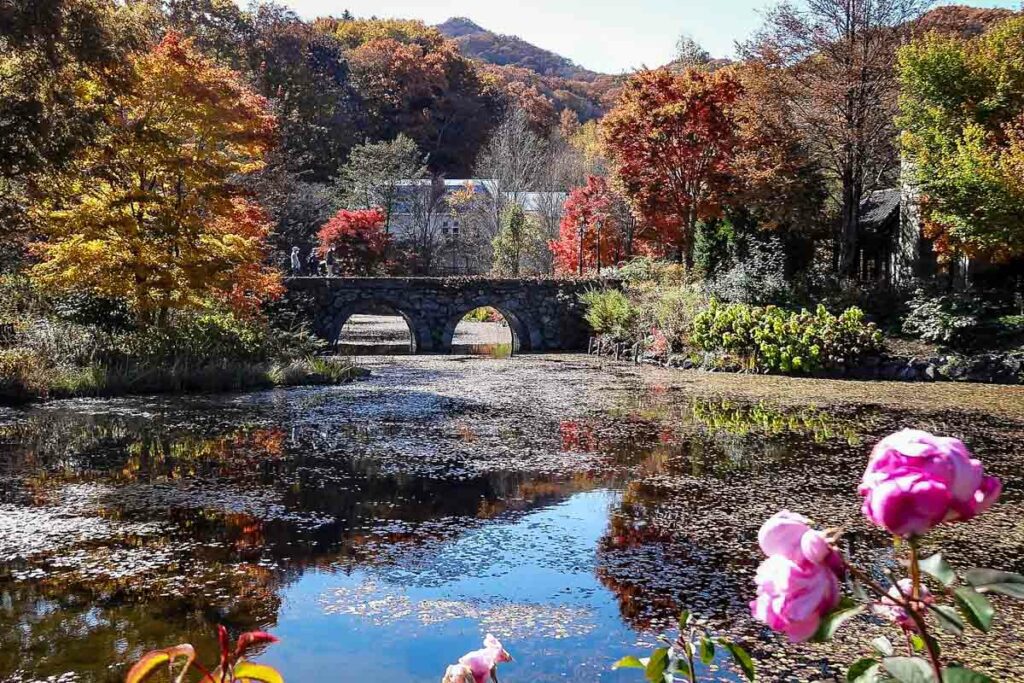
- At a glance: bougie resort town in the mountains
- Distance from Tokyo: 173 km / 107.5 miles
- Time: 1 hour 19 minute train ride / 2 hours 16 minutes driving
If you’re visiting Tokyo in the summer, Karuizawa might be just what you need for a reprieve from the sweltering heat and humidity. Due to its elevation, the town is known for having a refreshing climate even in the hottest months.
That said, with skiing and hot springs in the winter, springtime blooms, and breathtaking fall foliage, Karuizawa has something to offer in every season.
Made popular by wealthy expats who built vacation homes in the mountains to escape the summer heat, Karuizawa has some bougie attractions that cater to the luxury crowd, such as golf courses and the high-end designer brands found at Karuizawa Prince Shopping Plaza.
But if you know where to look, there are plenty of fun (sometimes free!) activities that even budget travelers can enjoy.
Top things to do in Karuizawa
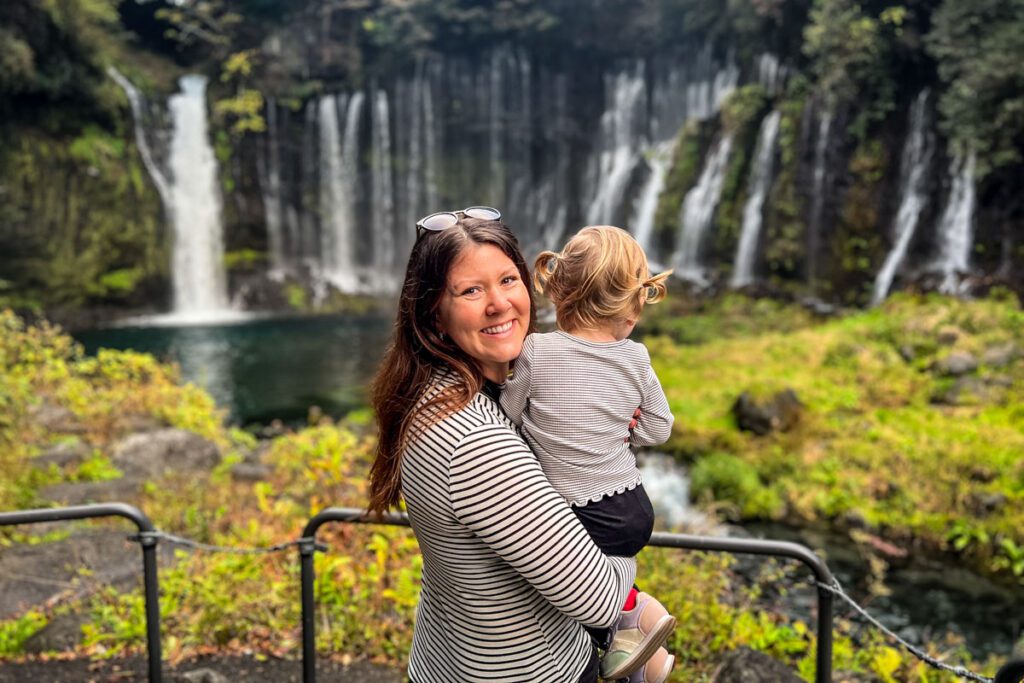
- Enjoy panoramic views from the Usui Pass Observation Platform. This lookout is free to visit and offers stunning alpine views of Gunma Prefecture on one side and Mount Asama on the other.
- Explore the Karuizawa Wild Bird Sanctuary. This natural conservation area is home to a diverse range of plant and animal species, from insects and birds to Asiatic black bears and the elusive musasabi (aka giant flying squirrel).
- Browse tour options here.
- Visit Onioshidashi Park, a surreal landscape of volcanic rock at the foot of Mount Asama within a national park.
- Go museum-hopping. Got unlucky with the weather? Karuizawa has you covered for rainy days with museums ranging from traditional art galleries and historical exhibits to the fun and family-friendly Trick Art Museum.
- Walk in famous footsteps at the Mampei Hotel, a historic Western-style hotel known as John Lennon’s favorite place to stay in Karuizawa.
- Chase waterfalls. There are several accessible cascades close to Karuizawa, including Shiraito Falls (one of our faves!), Tatsugaeshi Falls, and Senga Falls.
- Break a sweat on one of these day hikes ranging from moderate to challenging:
- Minenochaya – Shiraito Falls: 6.1 km out-and-back trail to a gorgeous waterfall
- Seventh Station – Mount Tateshina: challenging 4.8 km out-and-back hike up a steep mountain
- Sengataki Falls: 2.6 km out-and-back trail to a pretty waterfall
- Mount Kosama: 3.7 km out-and-back climb to panoramic views
How to get there
By train: From Ueno Station, take the Hokuriku-Shinkansen to Karuizawa Station.
By car: Get on the Kan-etsu Expressway (E17) heading northwest out of Tokyo. At Fujioka Junction, keep left for Joshin-etsu Expressway (E18), following signs for Nagano. Follow E18 to Usui-Karuizawa Interchange and exit onto Route 92. Continue onto Route 43 and make a left on Route 18.
By guided tour: This new day trip from Get Your Guide that includes Karuizawa, Hoshino Onsen, and Glacier Shrine has been getting great reviews.
15. Sayama Hills
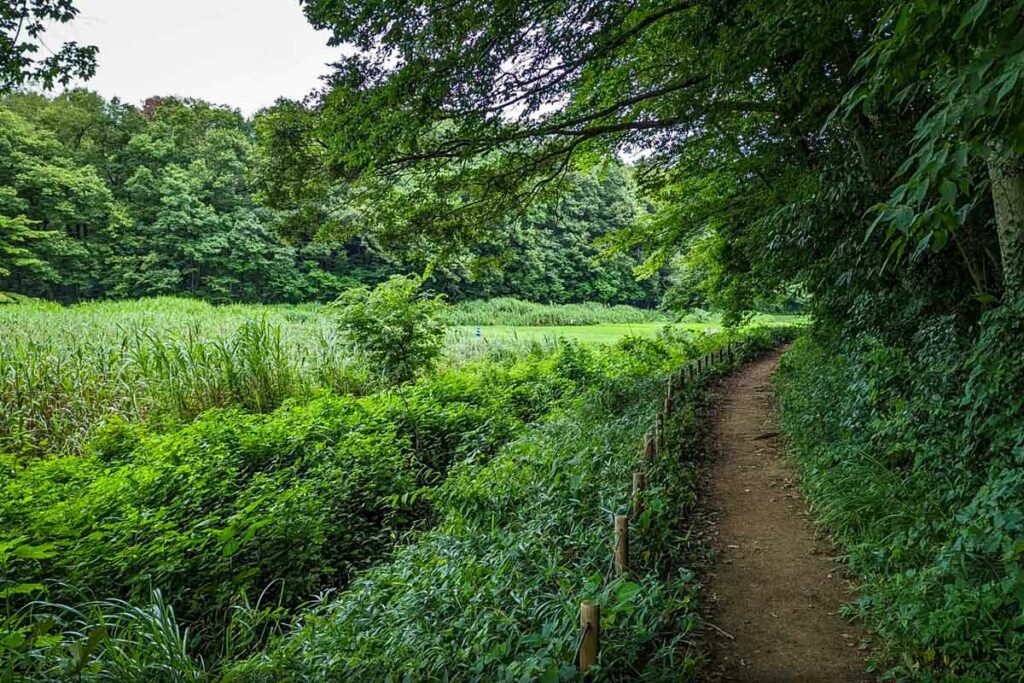
- At a glance: verdant landscapes and scenic hiking trails
- Distance from Tokyo: 49 km / 30.4 miles
- Time: 1 hour 24 minute train ride / 56 minutes driving
Just north of Japan’s sprawling metropolis in Saitama Prefecture, Sayama Hills is one of the best day trips from Tokyo for those seeking a nature break off the typical tourist path.
In less than two hours, you can swap the chaos of the city for peaceful woods where butterflies dance in soft sunlight filtering through a green canopy.
More popular with locals than with tourists, Sayama Hills is best known for its role in inspiring the forest setting of the Studio Ghibli film, My Neighbor Totoro. Affectionately known as “Totoro’s Forest”, the park is dotted with signs that share tidbits about the film.
Top things to do in Sayama Hills
- Wander the wooded trails of Sayama Hills, aka Totoro’s Forest. Even those unfamiliar with the Ghibli character can appreciate the peace and beauty of these magical woods.
- Hang out in Sayama Nature Park, a lakeside park with picnic tables, walking trails, and sports ground.
- Stroll or cycle around Sayama Lake.
- Explore Miyaderafukuronooka Park, a nearby nature preserve with hiking trails, a Dragonfly Swamp, and the Saitama Green Forest Museum. This loop is a good choice for a decent hike you can do in around 2 hours.
How to get there
By train: From Ikebukuro Station, take the Ikebukuro Line Express Hanno train to Kotesashi Station, then catch a local bus to your destination.
By car: Head north out of Tokyo on Route 5 and turn left on Route 311. In Nerima City, make a right onto Mejiro-dori Avenue and continue onto Kan-etsu Expressway (E17). At Tokorozawa Interchange, exit onto Route 463 toward Tokorozawa/Saitama. Continue onto Route 179 and follow to your destination.
How to get to these day trips from Tokyo
Getting to and from Tokyo to visit these places takes a bit of pre-planning, but you have a few different options for transportation.
Traveling around Japan by train
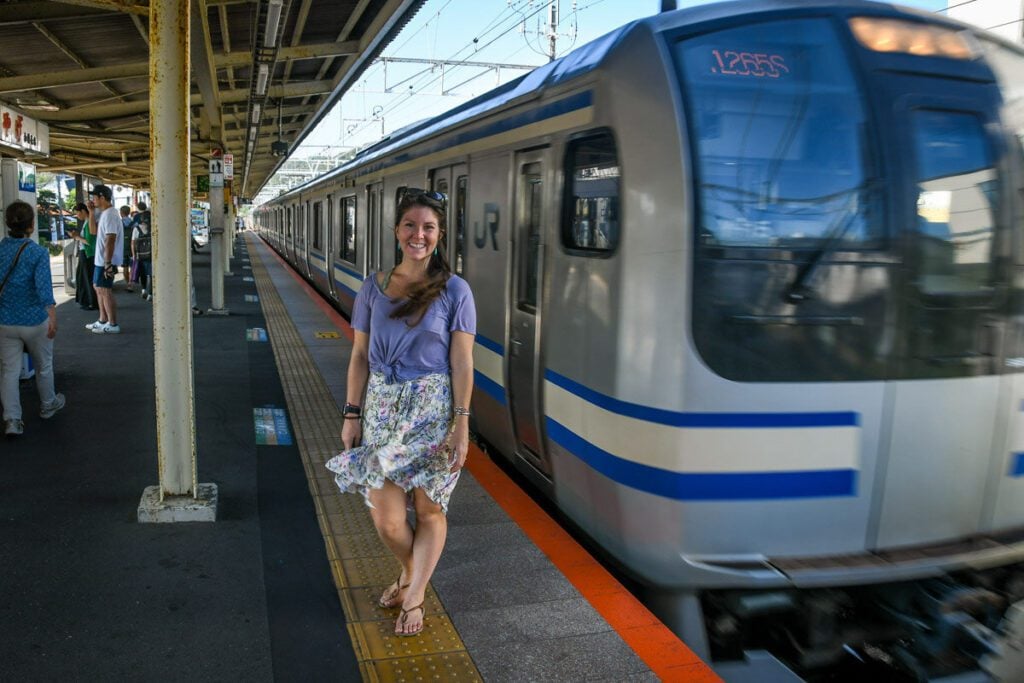
Japan’s railway system is known around the world for being clean, fast, and efficient. Between the famous Shinkansen bullet trains, regional rails, and local metros, most of the major tourist destinations in Japan are accessible by train.
The only major downfall about the trains in Japan is that a single ride can be expensive. Depending on where you’re going, it can be very expensive.
But you know us; we love finding sneaky ways to travel (even notoriously expensive countries) on a budget. And we love sharing our secrets with you, so here it is: our VERY detailed guide to train travel in Japan.
→ Want more tips on traveling Japan on a budget? We have a few practical money-saving tricks up our sleeves that you’ll definitely want to save!
Getting a rental car in Tokyo
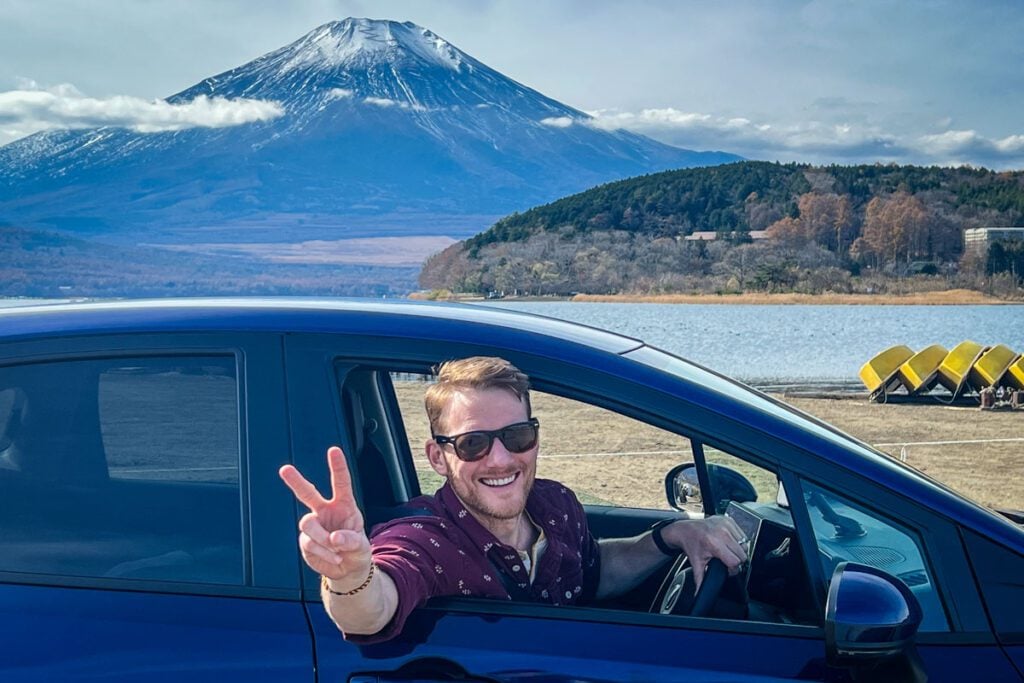
Having your own vehicle when visiting will give you a lot more freedom to explore the best day trips from Tokyo.
We personally like using Booking.com (formerly RentalCars.com) when we rent vehicles in Japan, as they gather options from all sorts of rental companies in one place. It makes it really easy to compare prices and vehicles so you can determine which is the best option for you.
Search & Compare Rental Car Prices
- Discover Cars: We personally use this aggregate site to compare rental car prices from all the big name companies and get the best price possible.
- RentalCars.com: We’ve had good experiences finding rental cars with this site in the past.
Before you book, be sure to read our guide to renting a car in Japan. It’s packed with things you need to know before you get behind the wheel, as well as insider tips to help you feel confident on the road.
First timer’s guide to Tokyo
If this is your first time visiting Tokyo, you’ll want to read our First Timer’s guide which is packed with helpful information like how to get around and where to find the best eats.
Where to stay in Tokyo
In this guide we break down the best neighborhoods in Tokyo to find short term accommodation when visiting. Plus, we’ve included our top recommendations for hotels and Airbnbs.
Perfect Tokyo itinerary
Want your Tokyo itinerary planned for you? No problem! We did the legwork and came up with what we think is the perfect route for a 5-day Tokyo itinerary for your first visit.
Plan your trip to Japan
After 3 trips (and counting!), we’ve fallen head over heels for Japan—and we’ve created TONS of resources to help you plan your dream trip. Start with our Ultimate Japan Travel Guide and be sure to check out these helpful articles:
- First time? Our Japan Trip Planner walks you through everything you need to know.
- Use our Japan Rail Pass guide to determine if getting a train pass is optimal for your trip.
- Here’s our curated list of the best things to do in Japan—from iconic sights to once-in-a-lifetime experiences.
- Not sure where to go? Our Japan itinerary ideas will help you map it all out.
- Foodies, rejoice! This guide to what to eat in Japan will have you drooling before you land.
- This guide to what to wear in Japan (and what not to wear) will help you blend in.
- Use our ultimate Japan Packing List to make sure you don’t forget anything.
- Before you go, brush up on these essential Japan travel tips (including major do’s and don’ts!).
- Avoid awkward moments by brushing up on Japanese etiquette.
Still have questions? Drop us a comment—we LOVE helping travelers plan unforgettable trips to Japan!
Perfect Japan itinerary
Want the perfect itinerary planned for you?

If you don’t have a ton of time to spend planning your Japan itinerary (or you just don’t find travel planning fun), we’ve got something you might be interested in…
We created the ultimate done-for-you Japan itinerary that is packed full of all sorts of tips we’ve gathered from 3 trips to Japan as well as literally hundreds of hours of research (no exaggeration).
We have both an off-the-beaten path route as well as a classic itinerary that hits the top attractions (perfect for your first visit to Japan!).
Don’t miss your chance to grab our Japan pocket guide!
This FREE PDF download includes everything you’re going to want to pack for your Japan trip, including what NOT to bring, plus tons of insider tips!
Just enter your email and we’ll immediately send you access instructions!
Save this article to Pinterest for later!
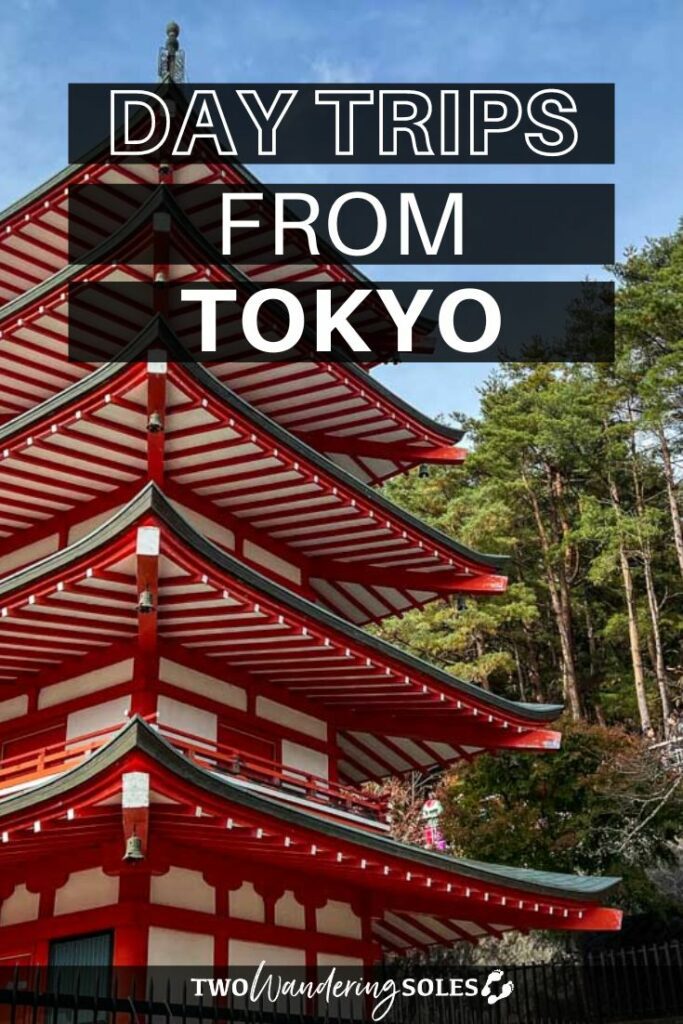
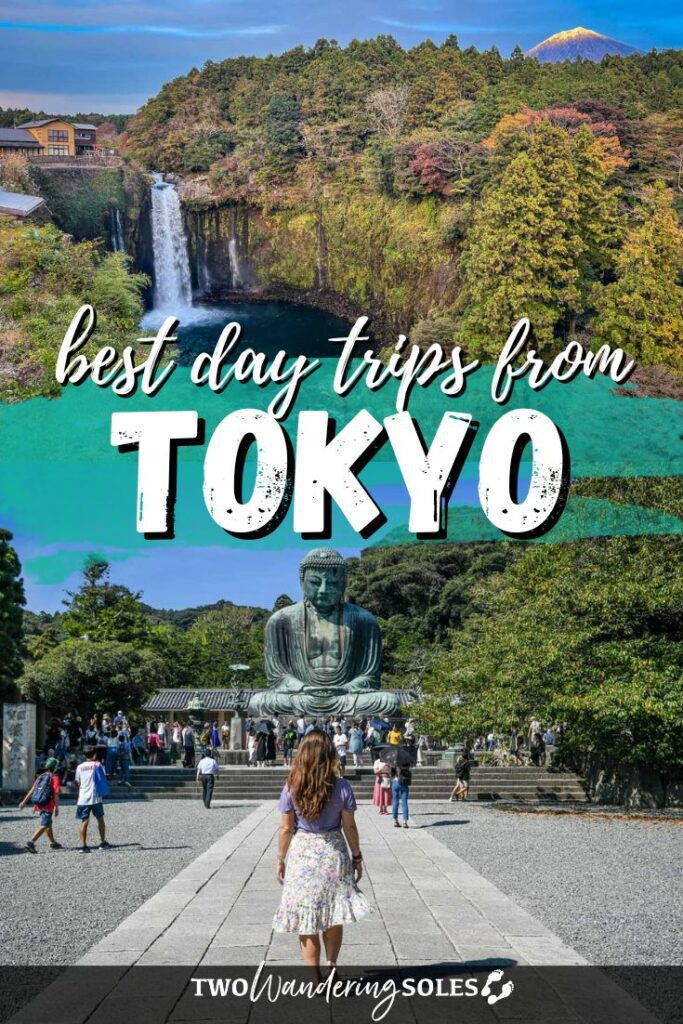
We want to hear from you!
Which of these day trips from Tokyo is up your alley? Do you have any suggestions we might have missed? Let us know in the comments below and we’ll do our best to get back to you!


